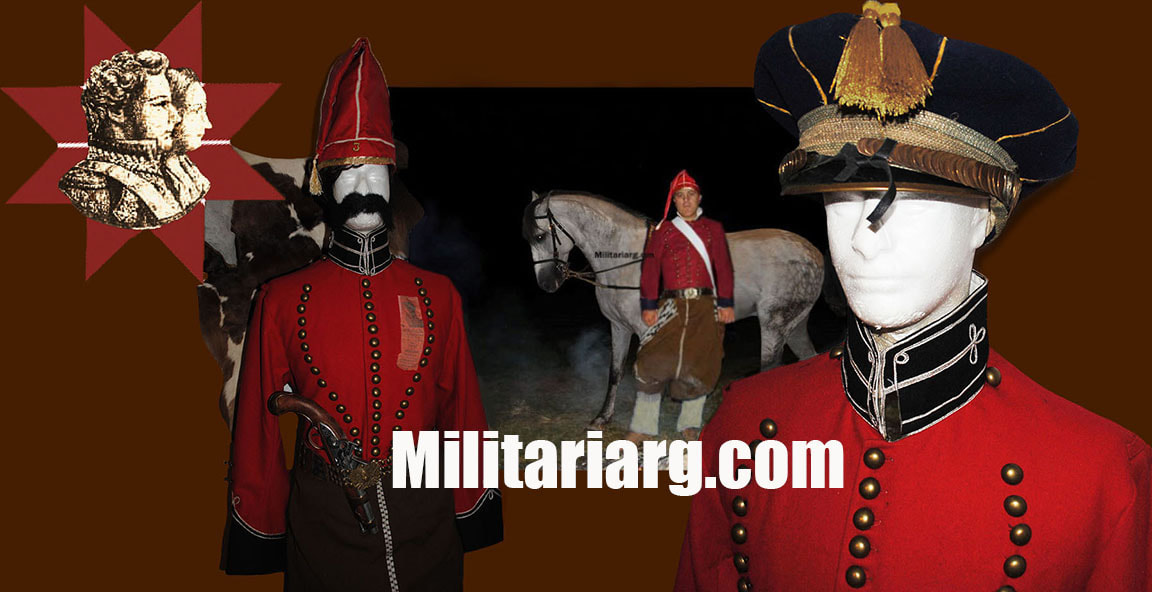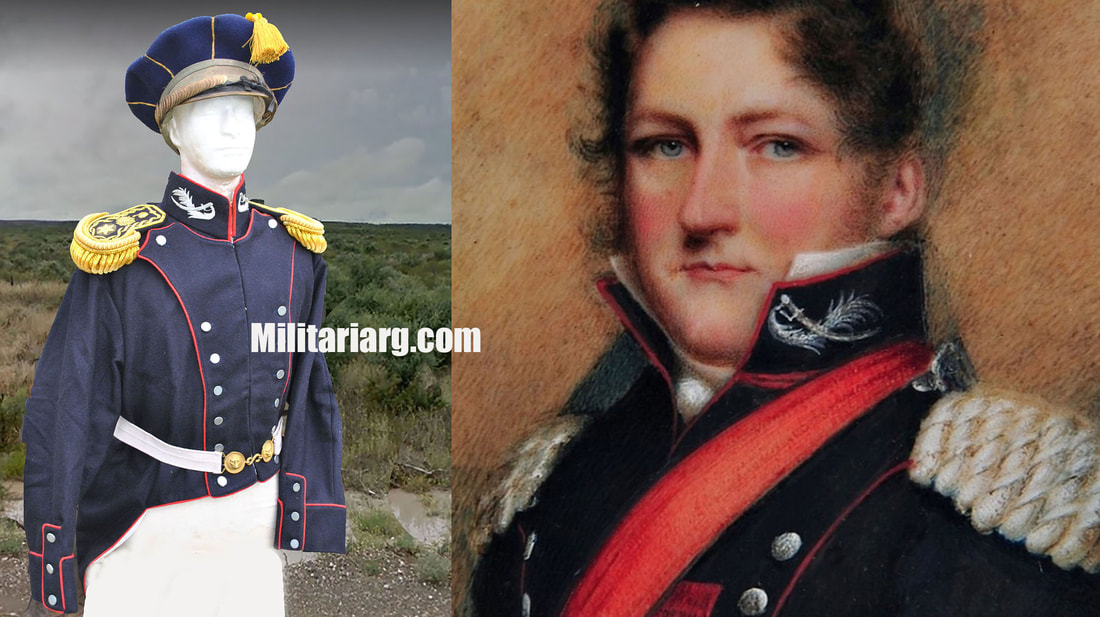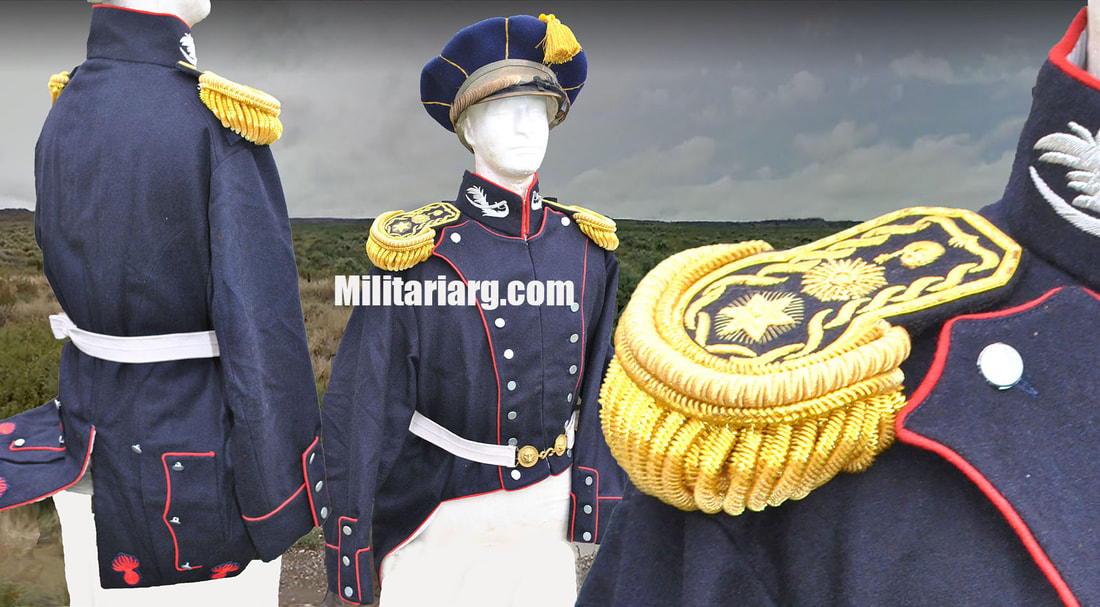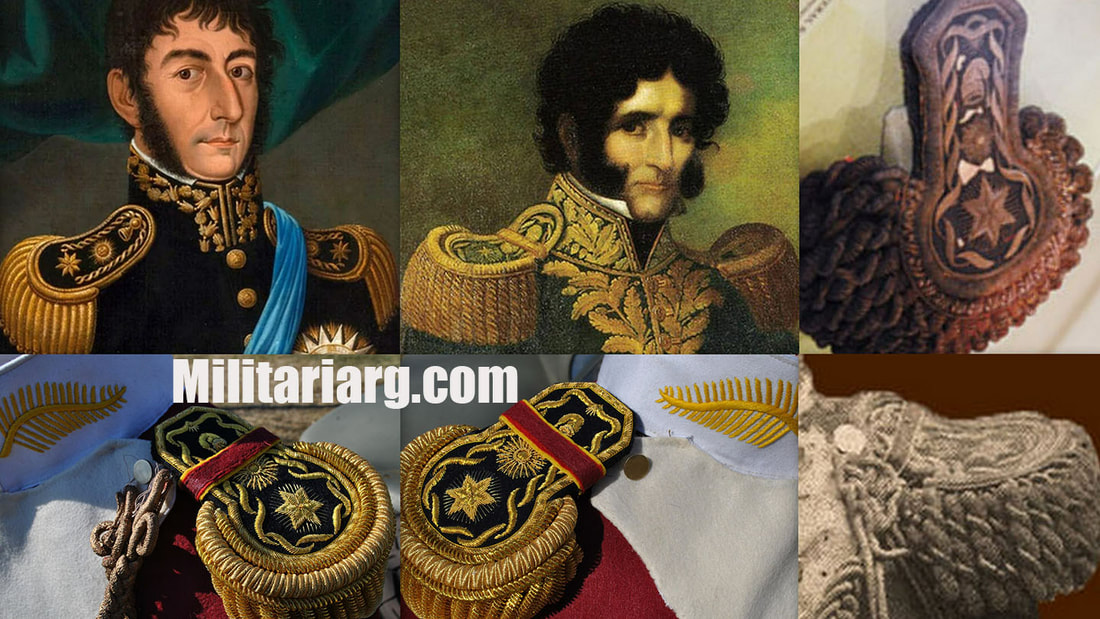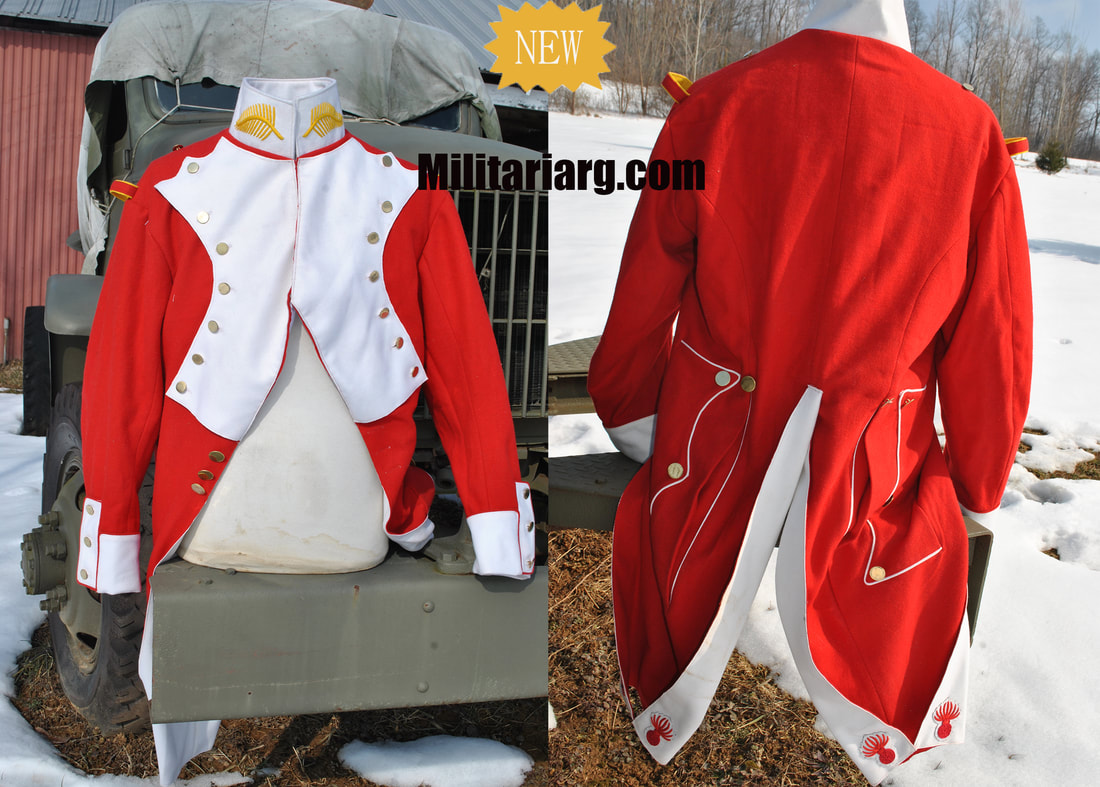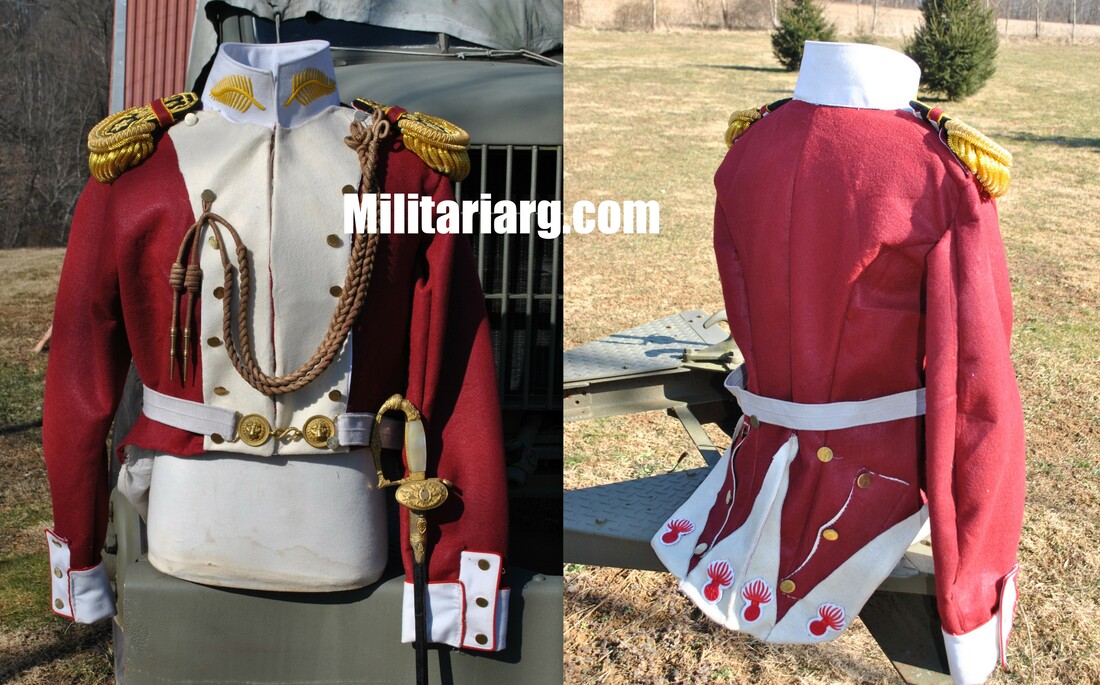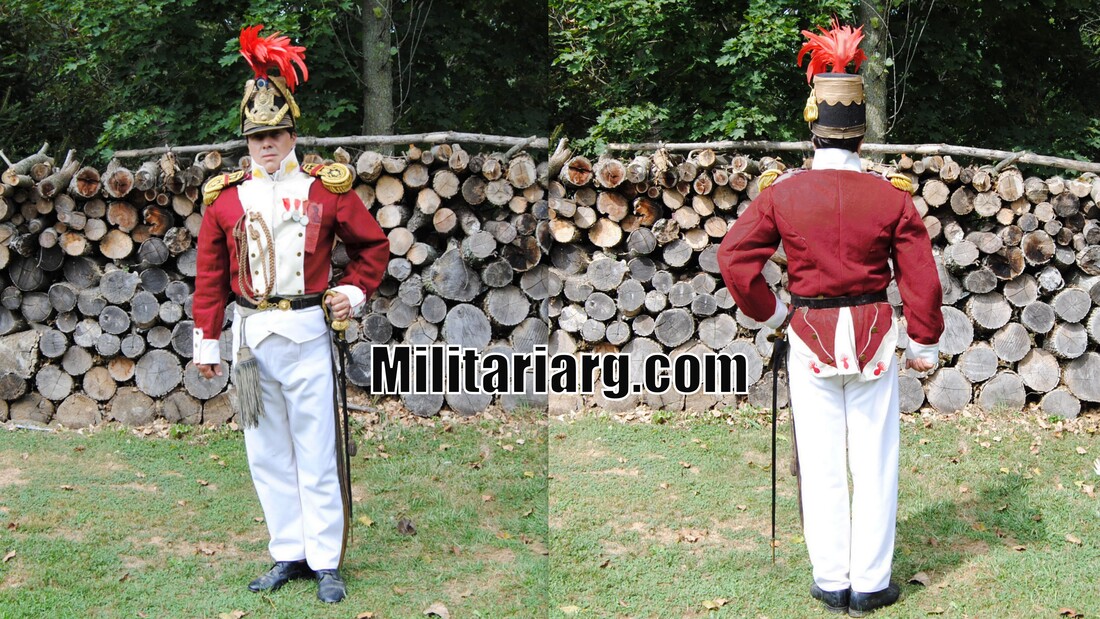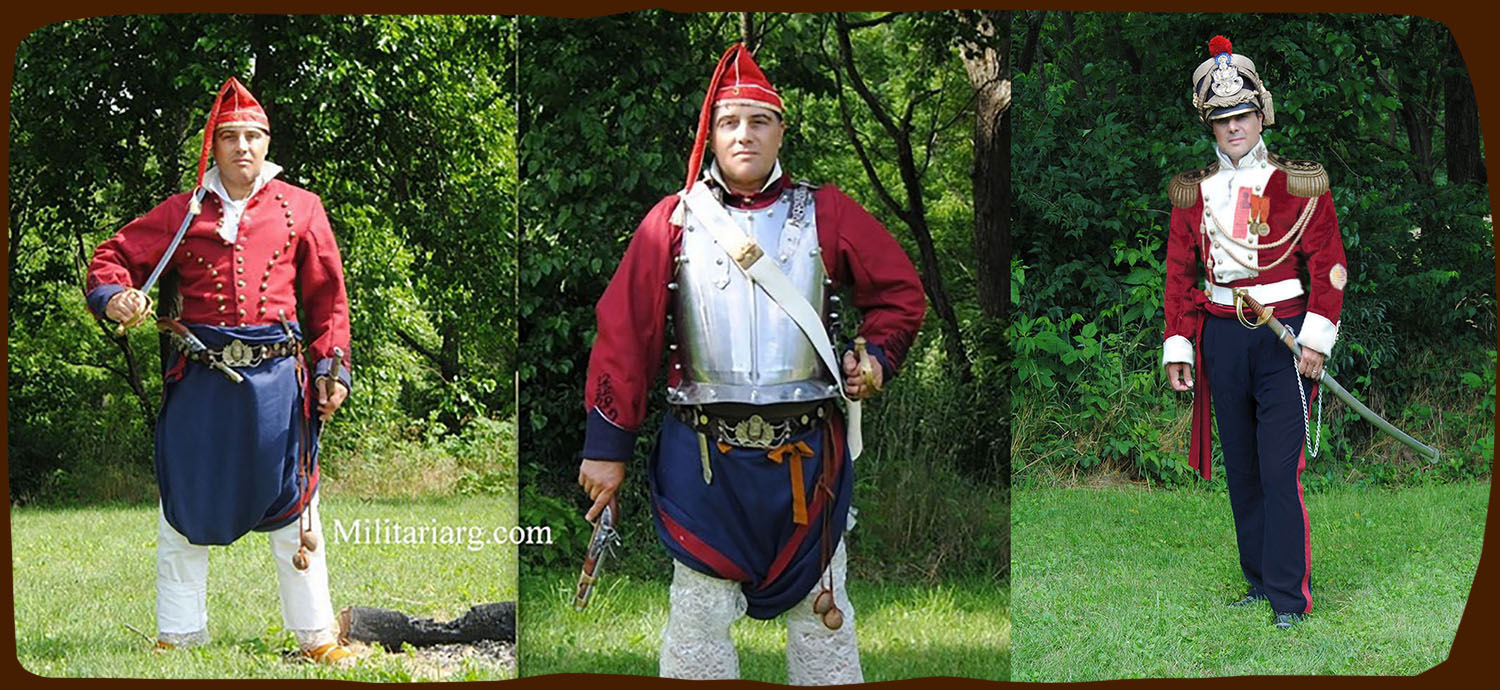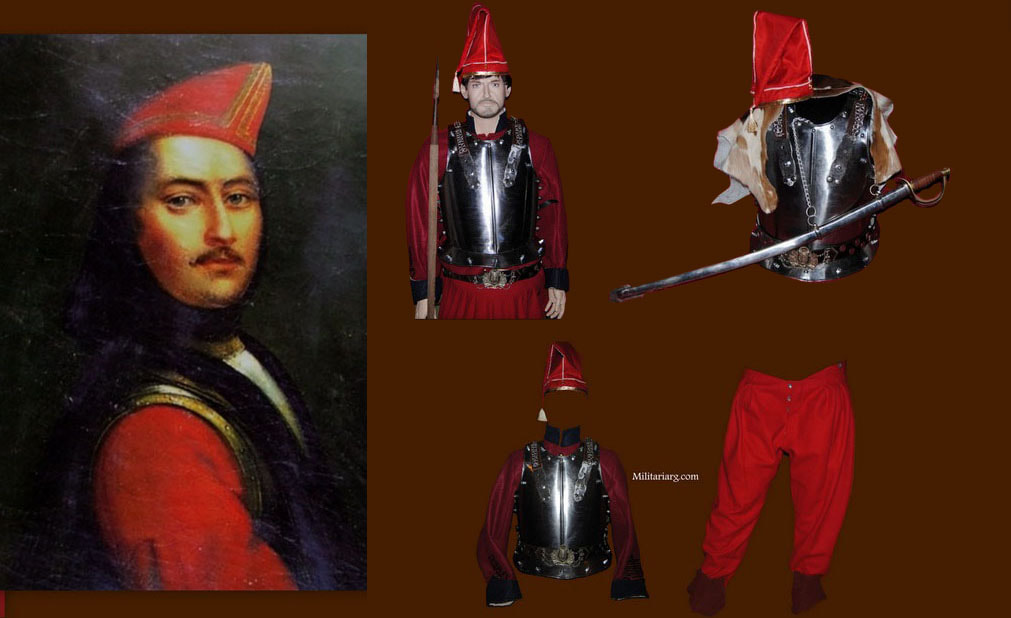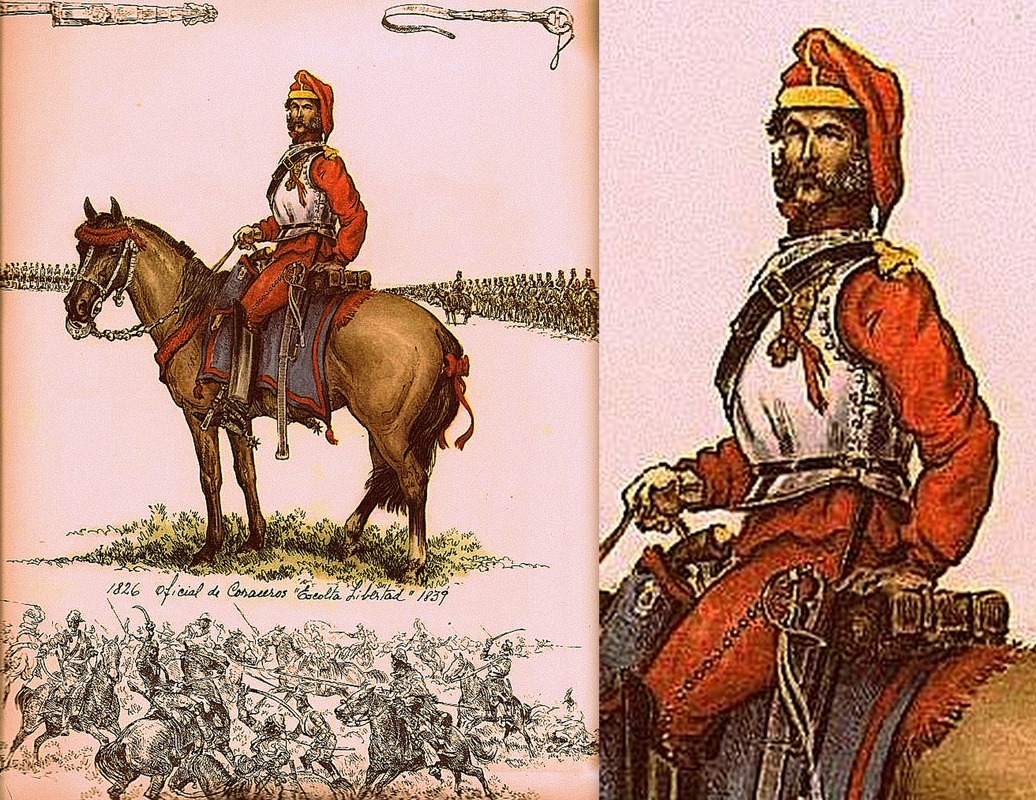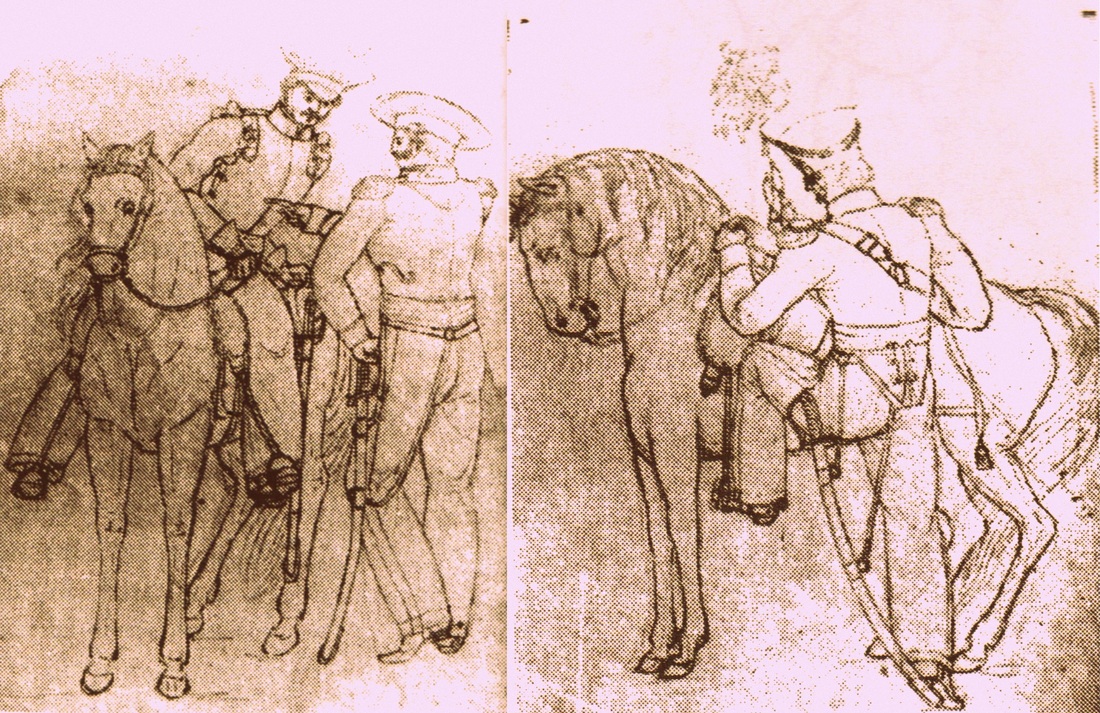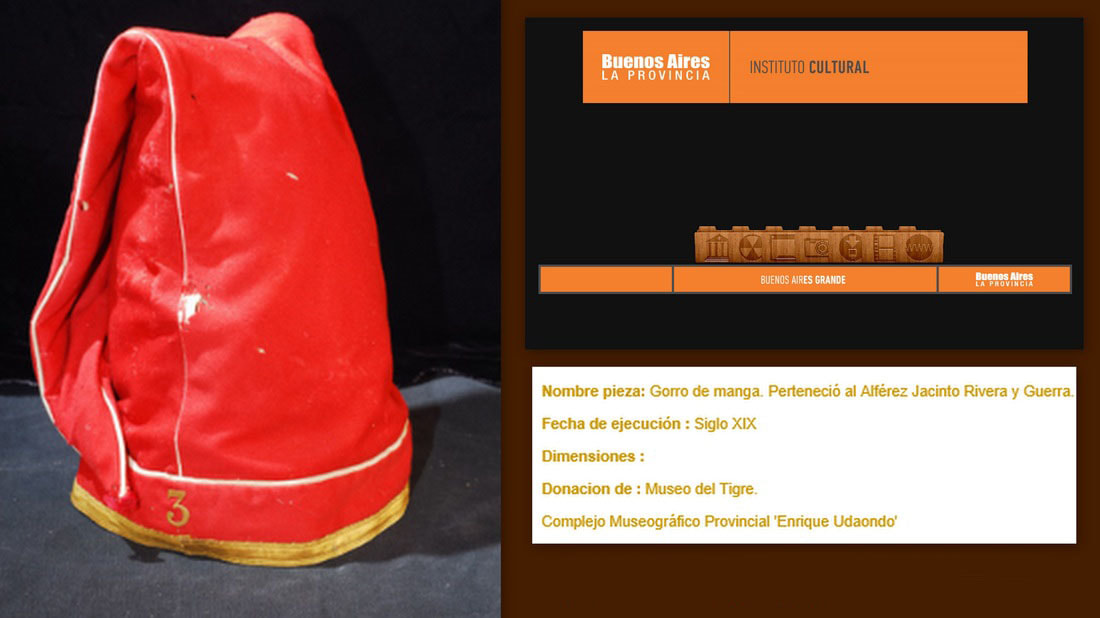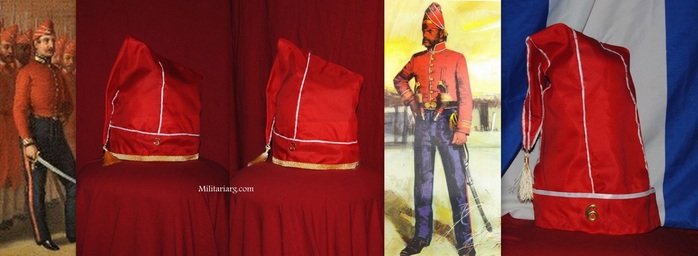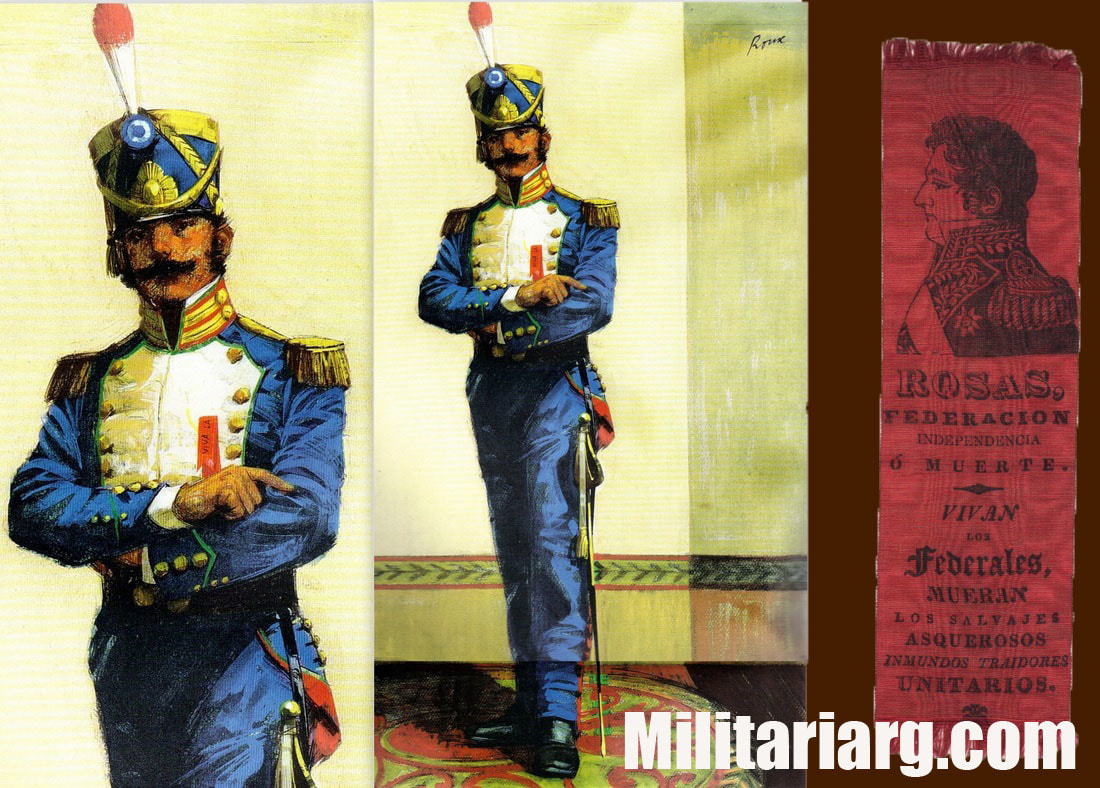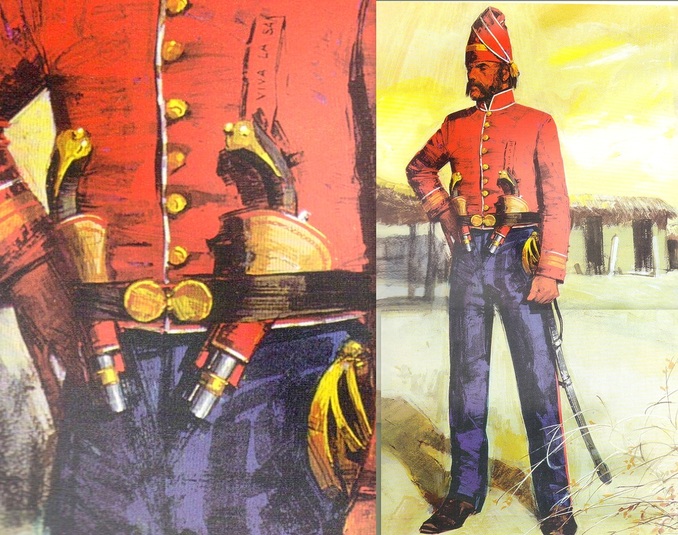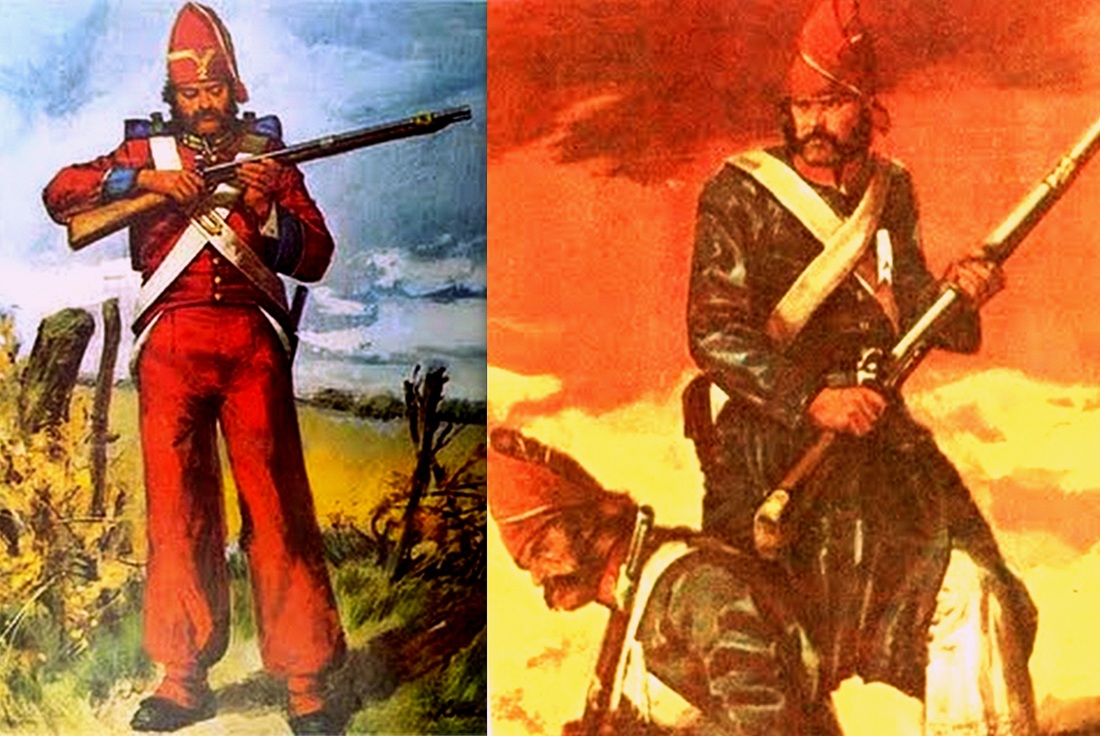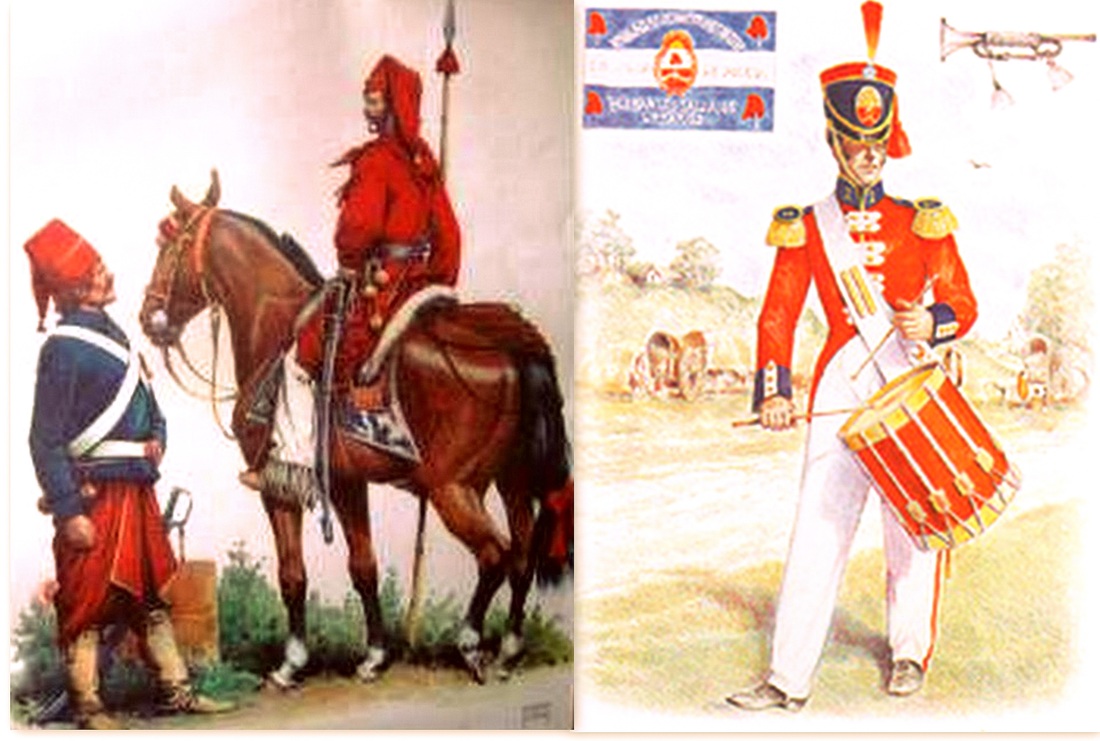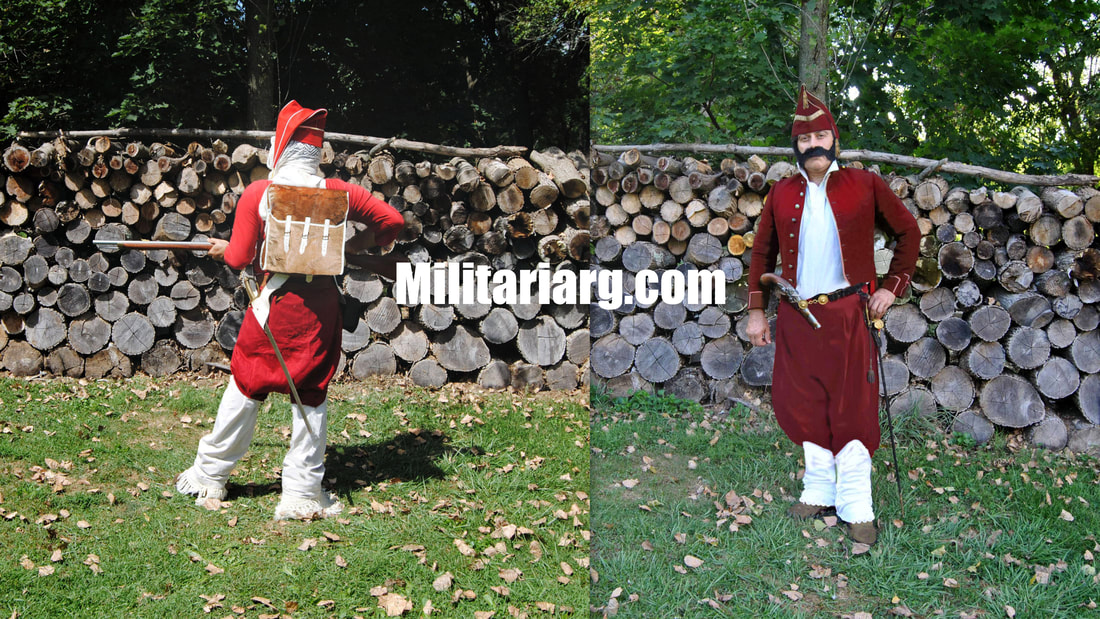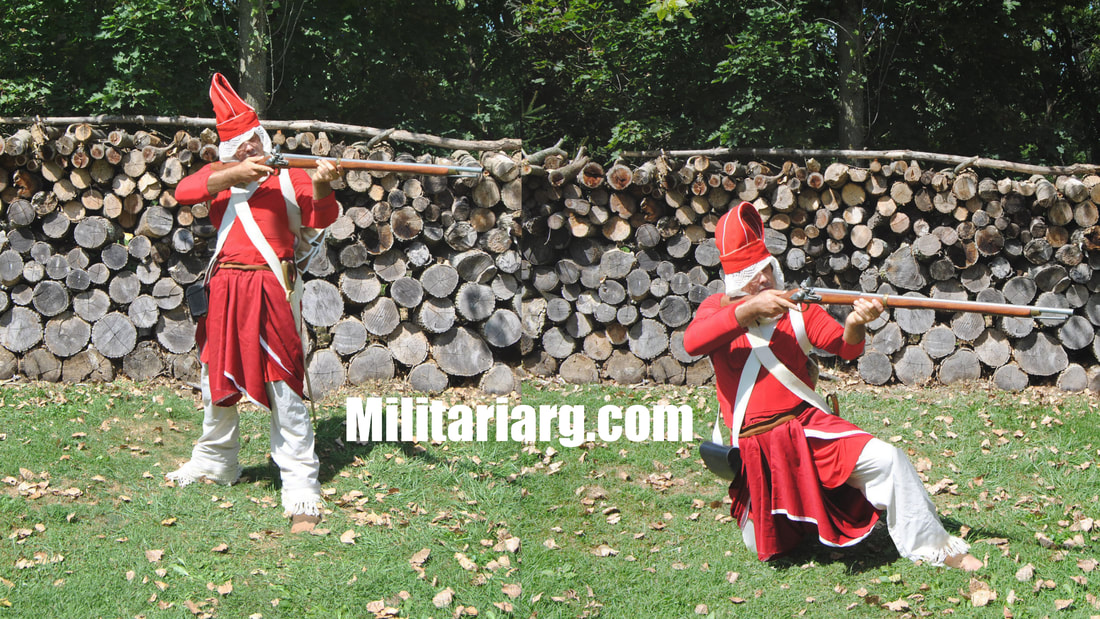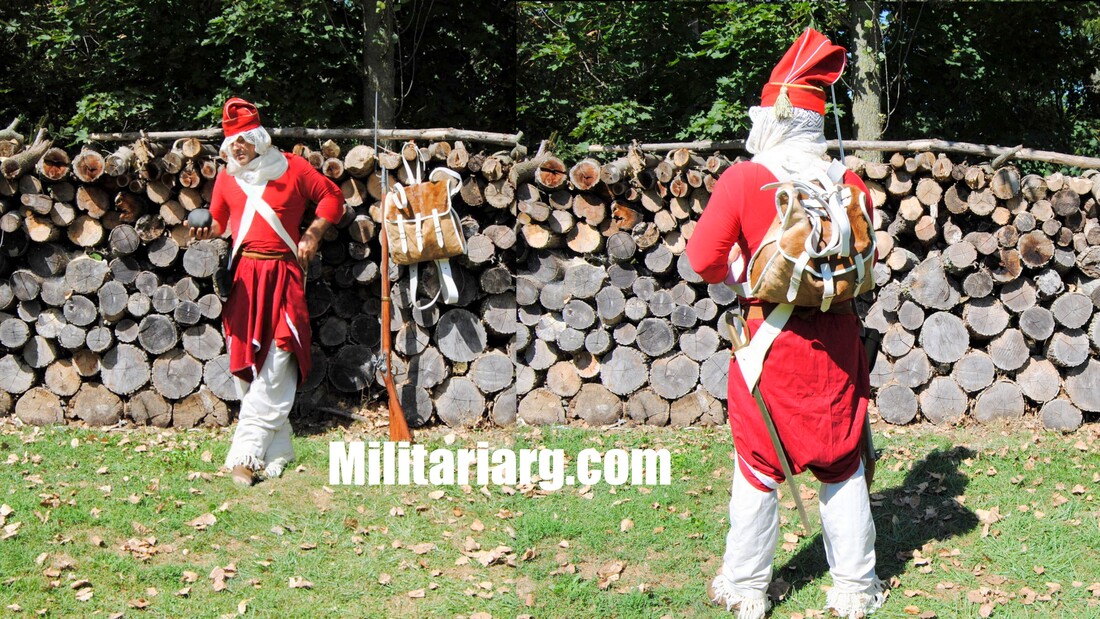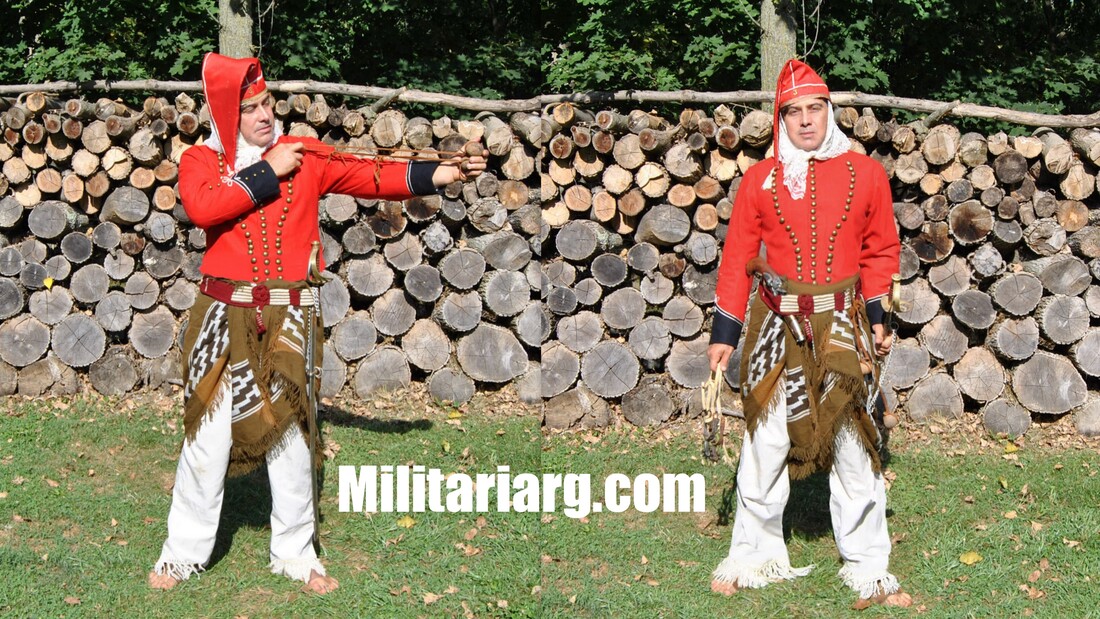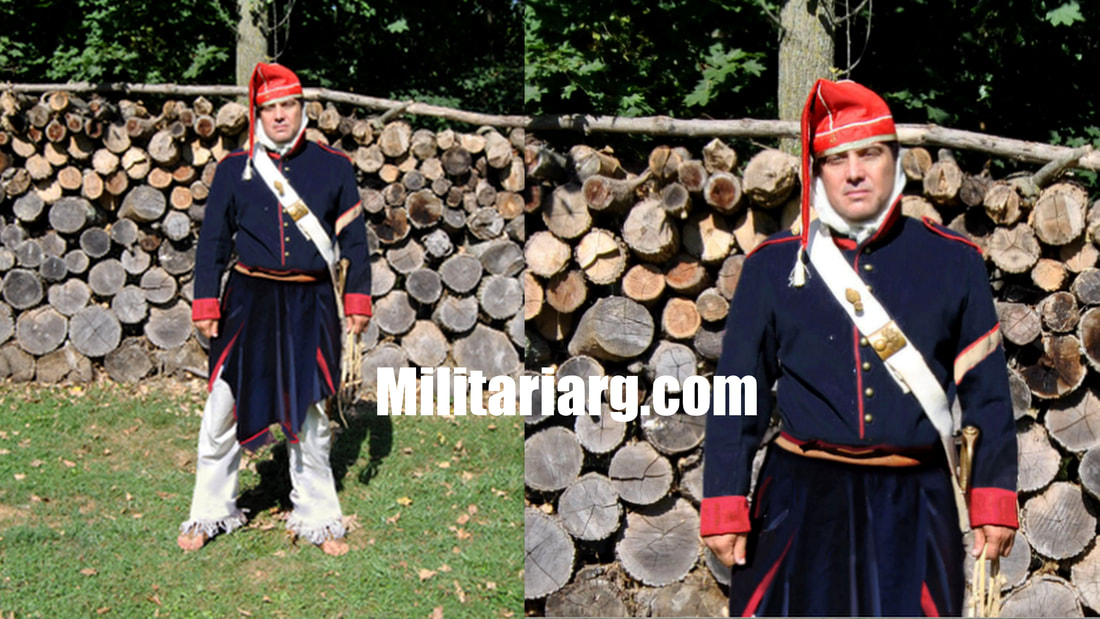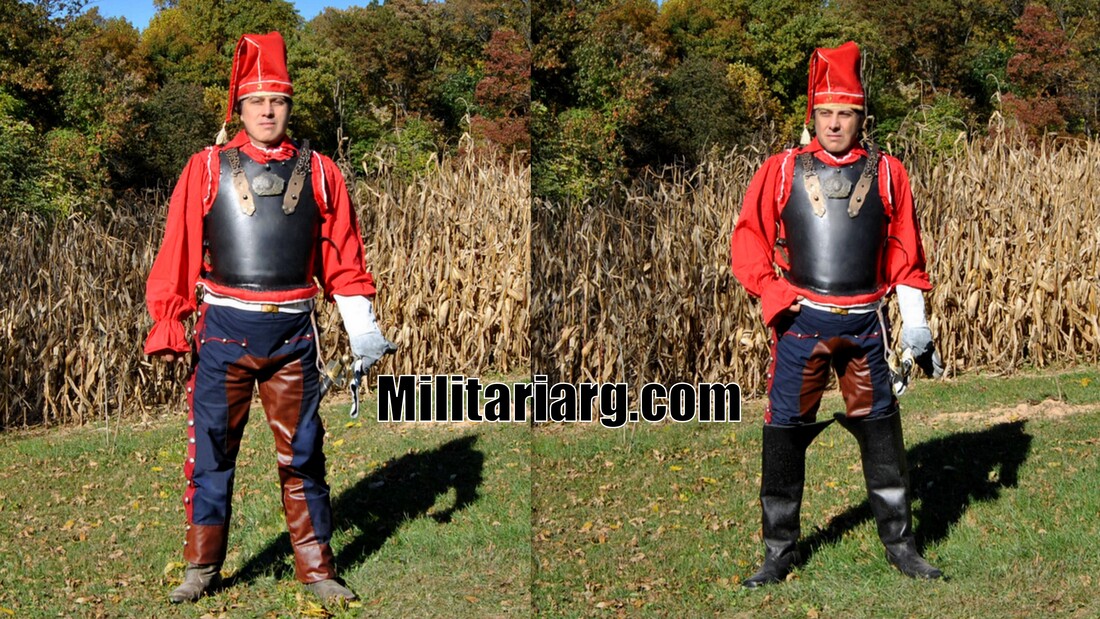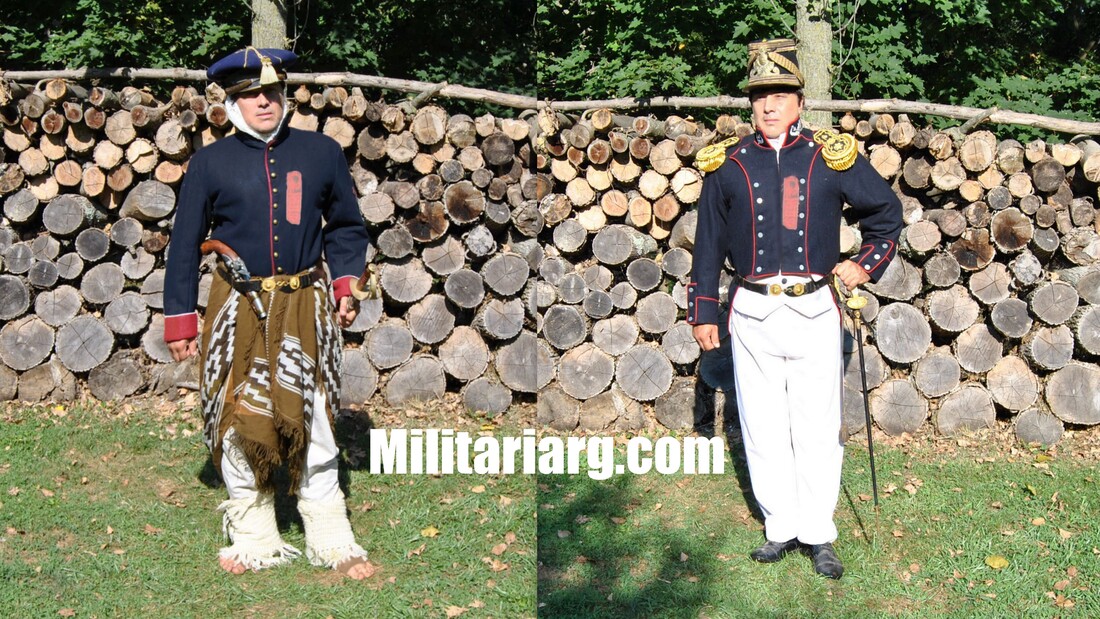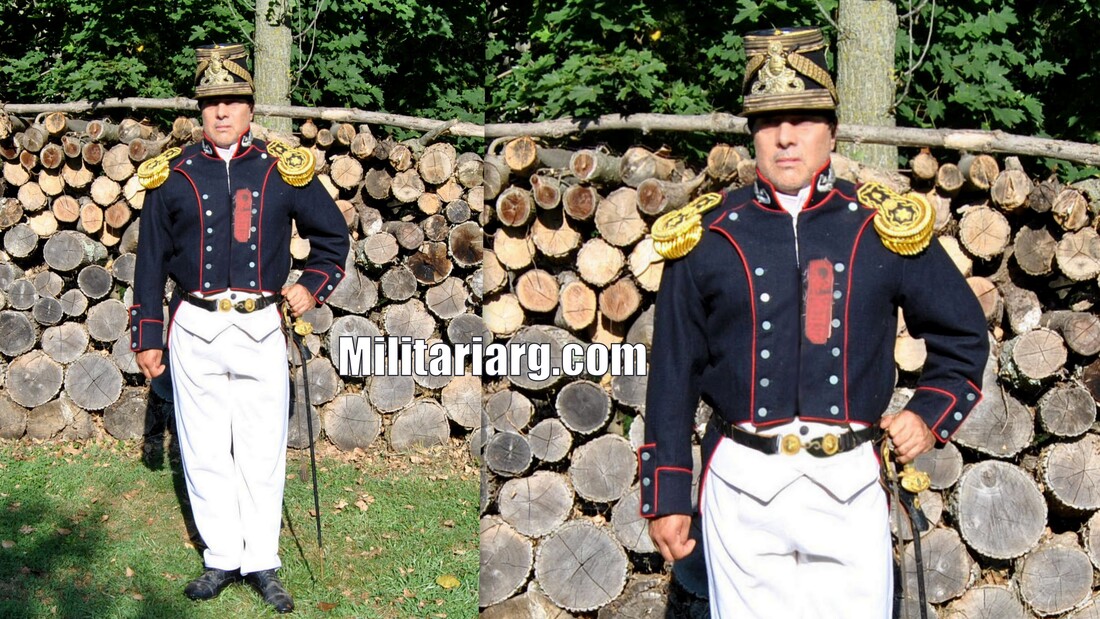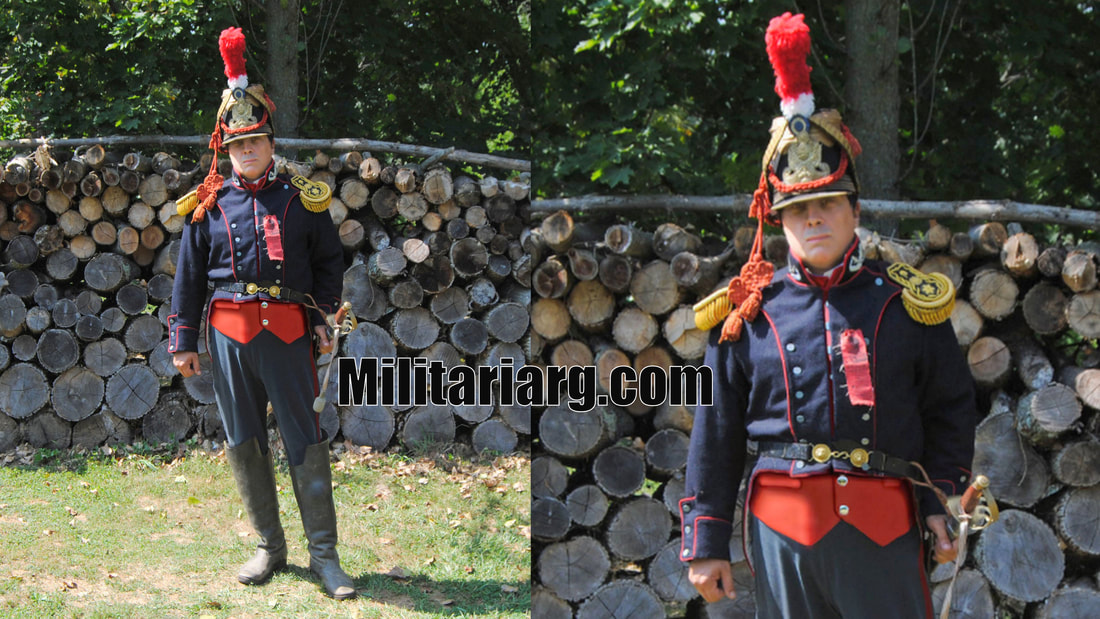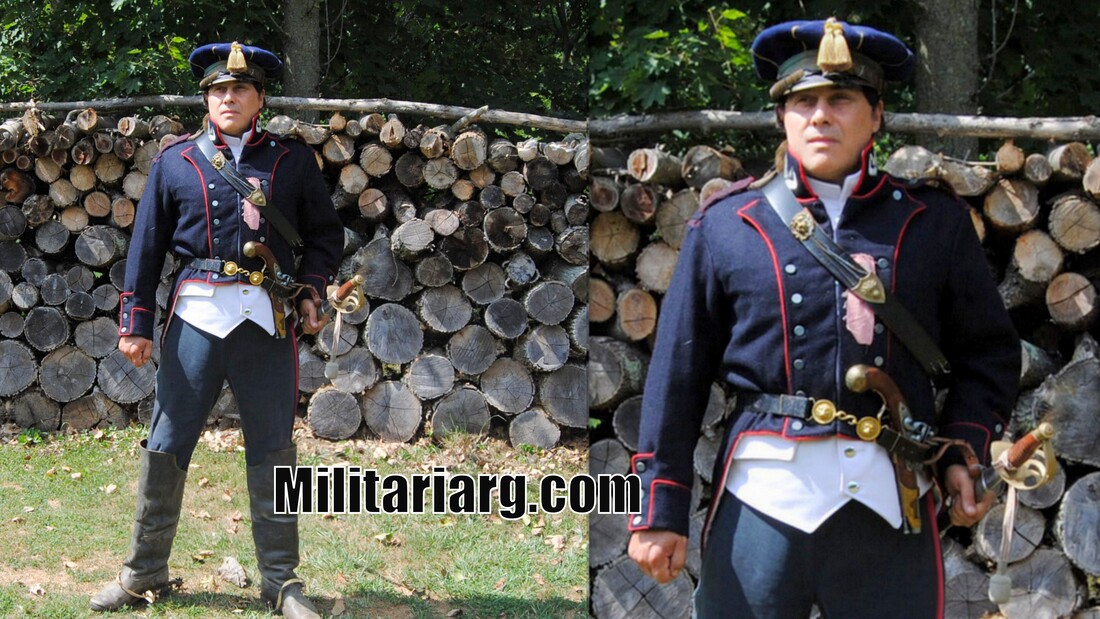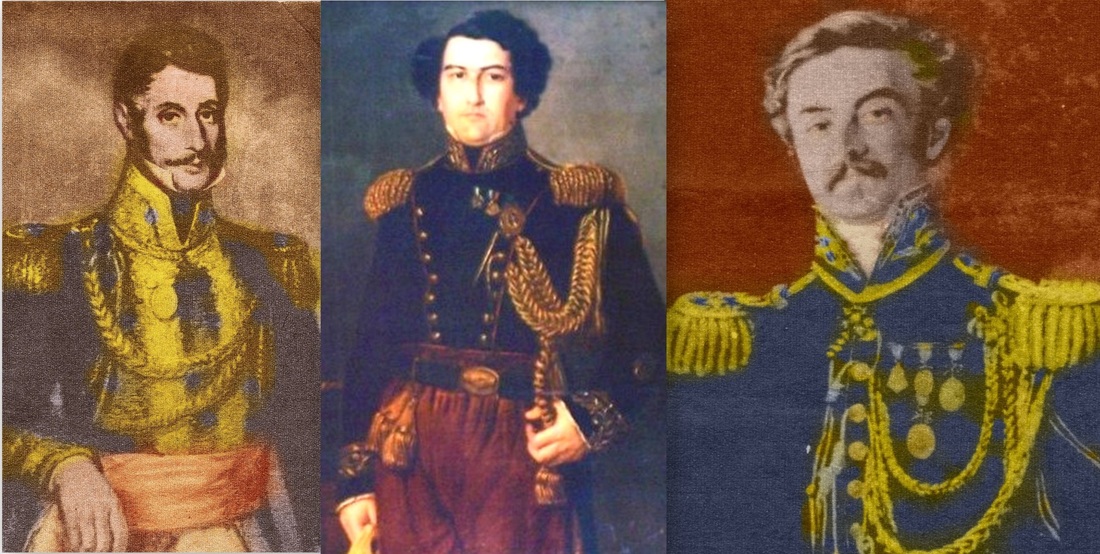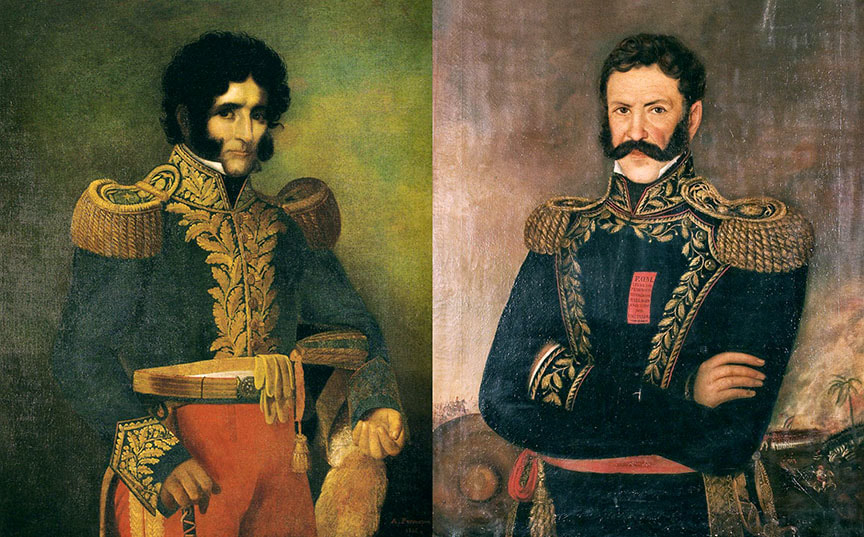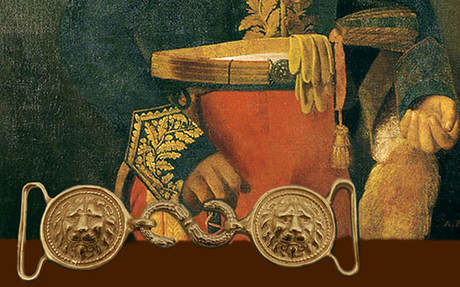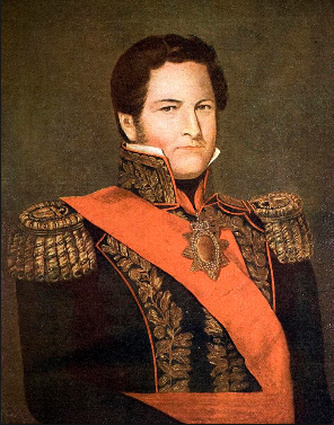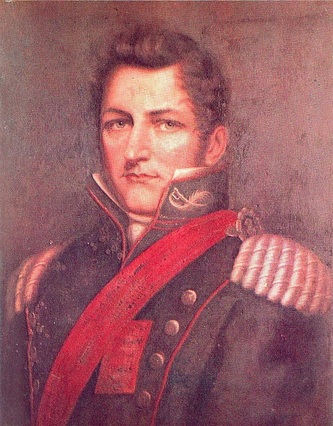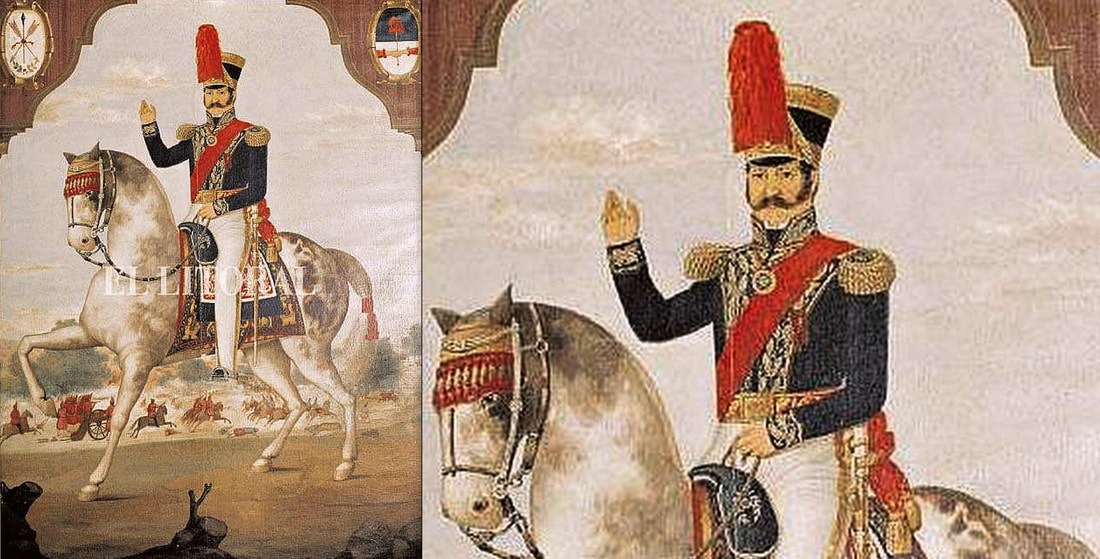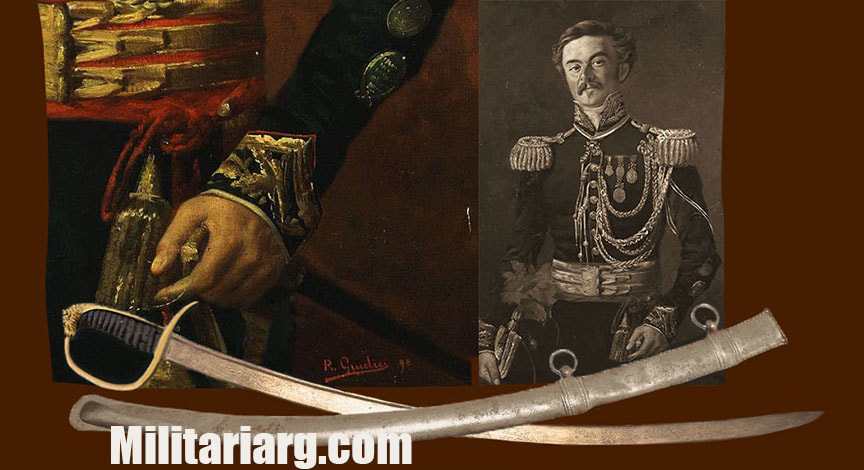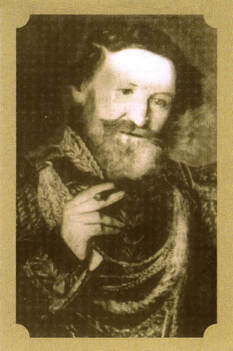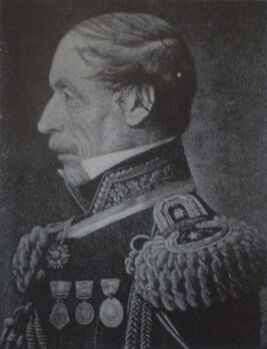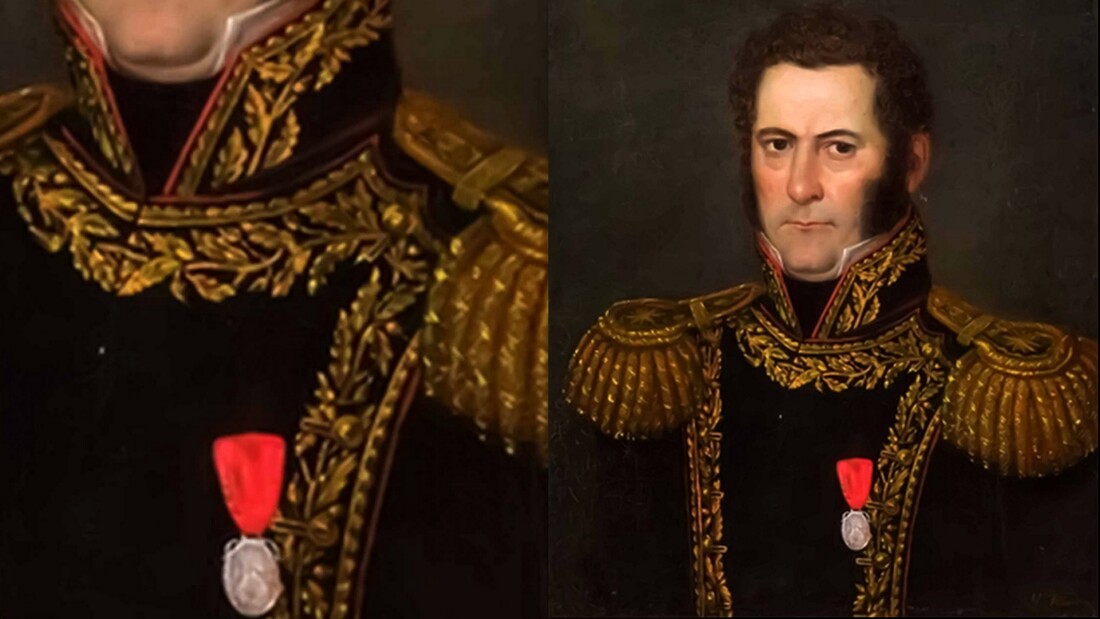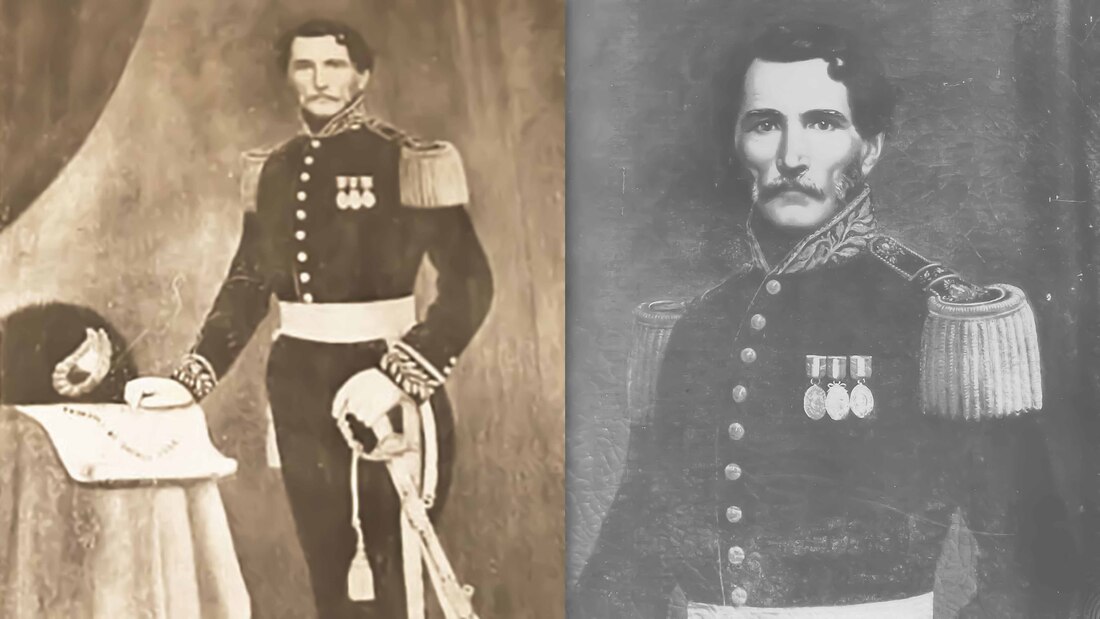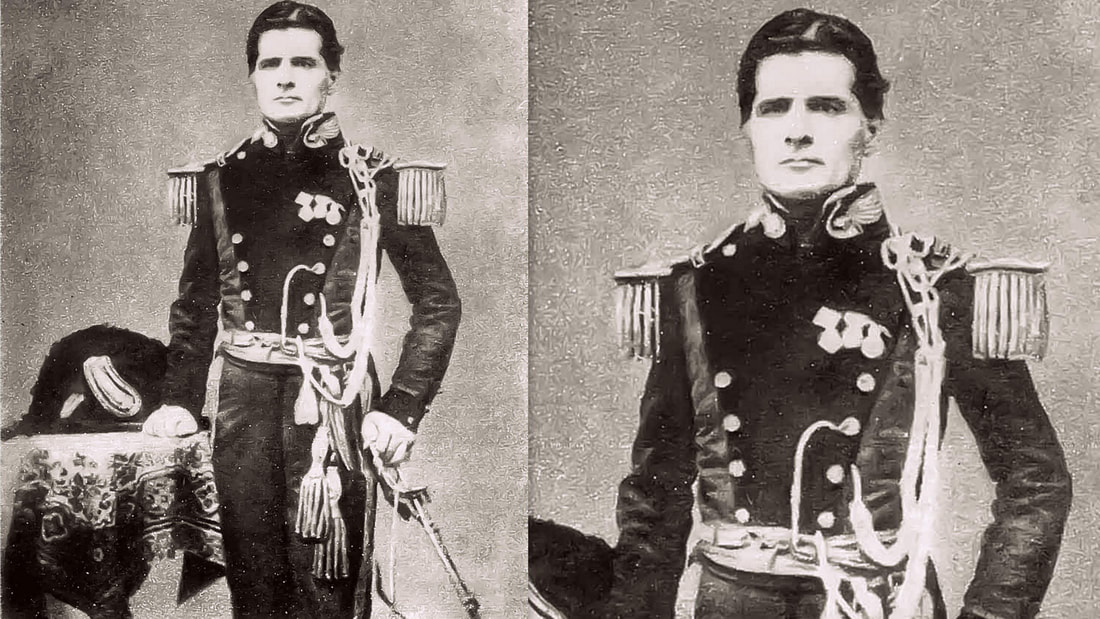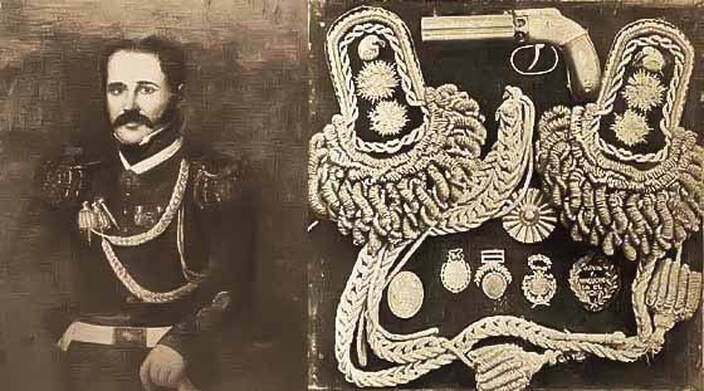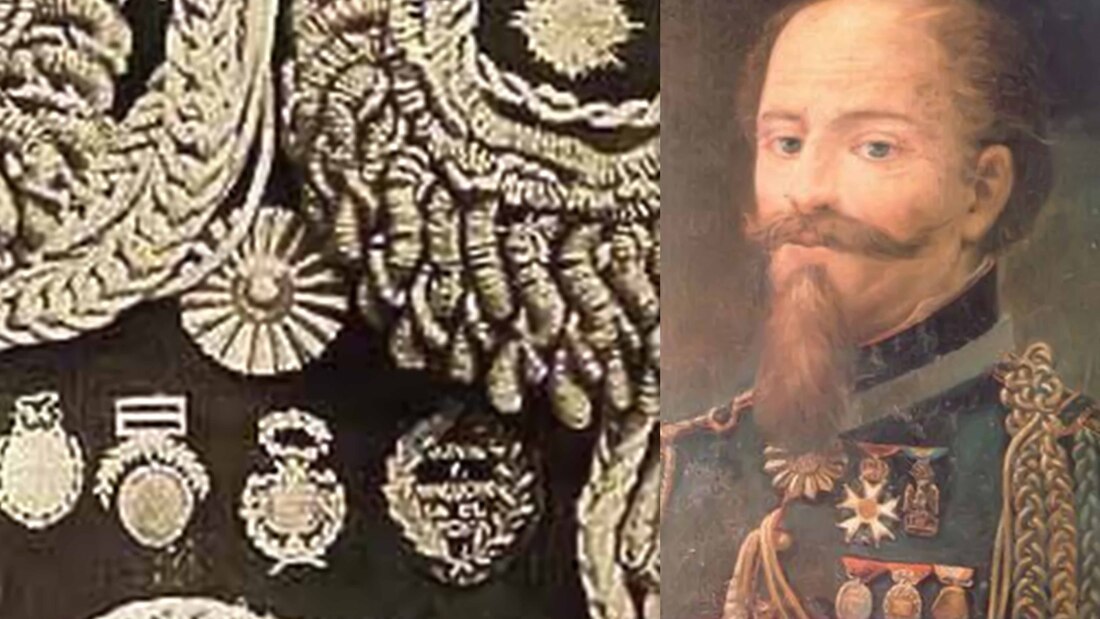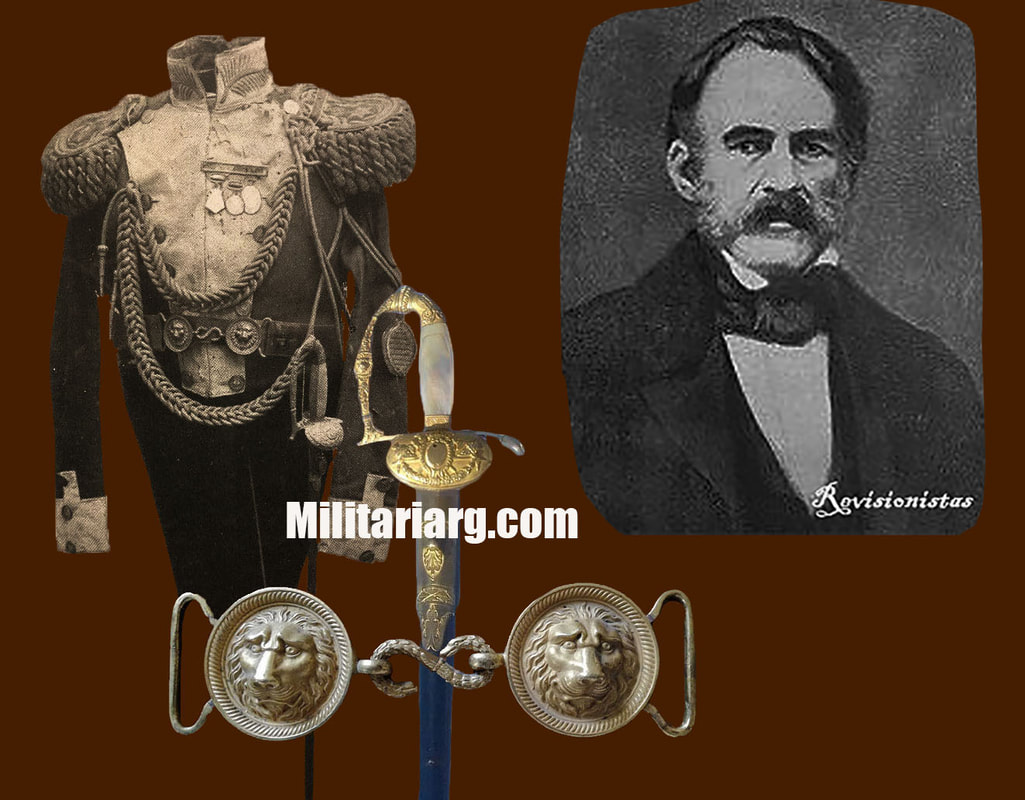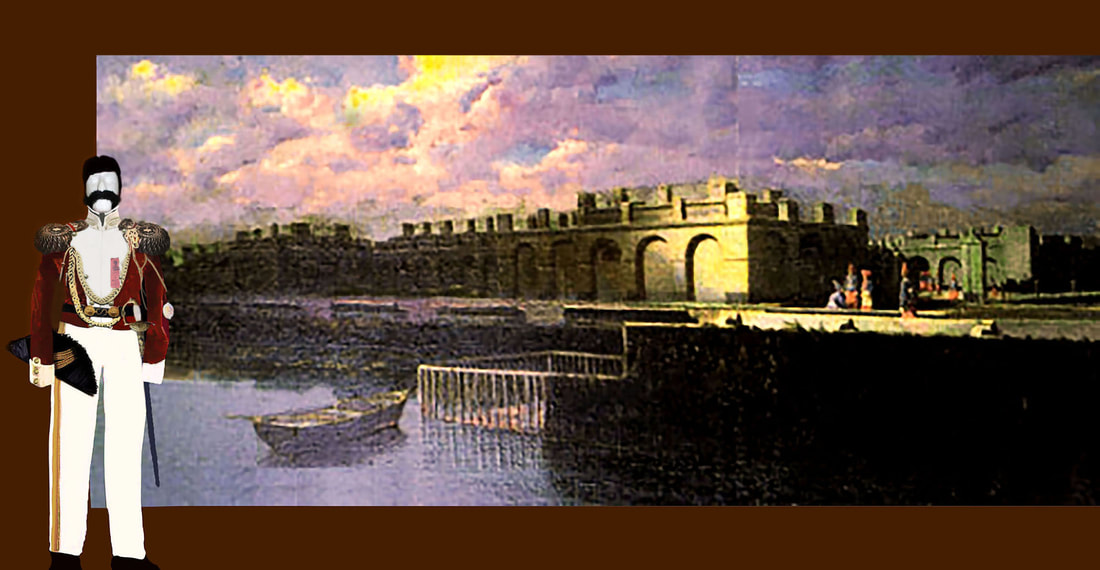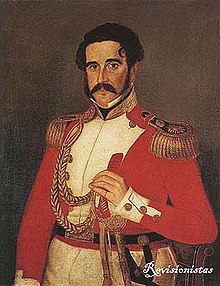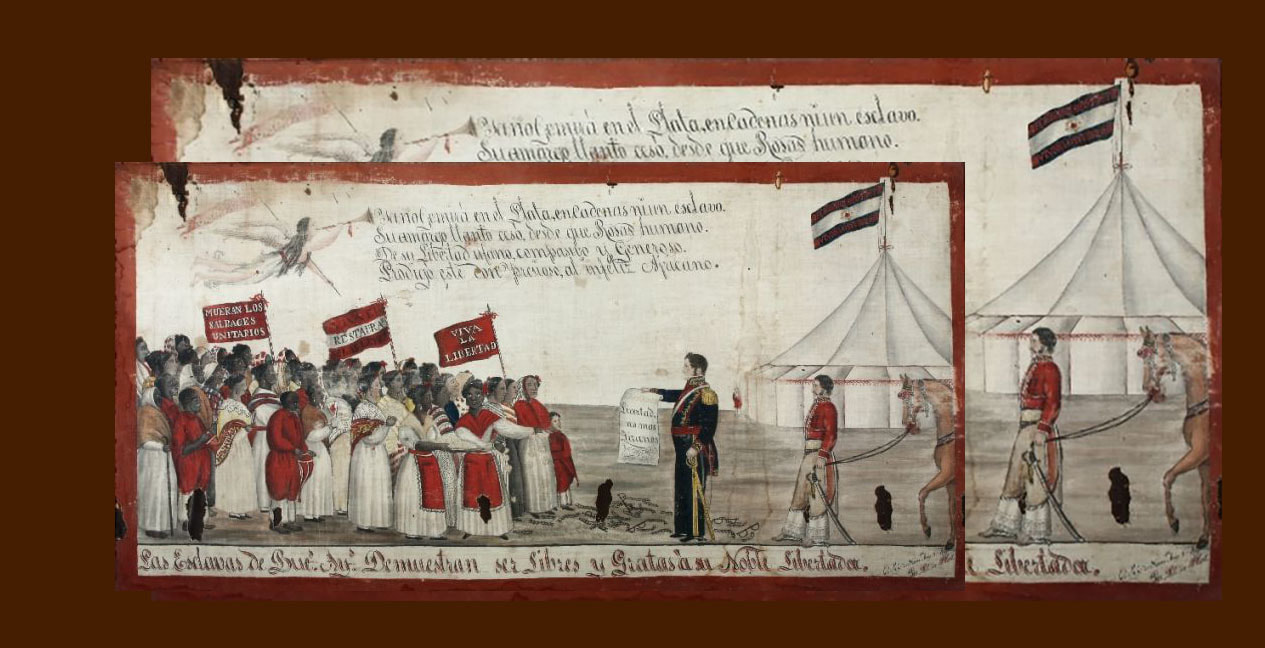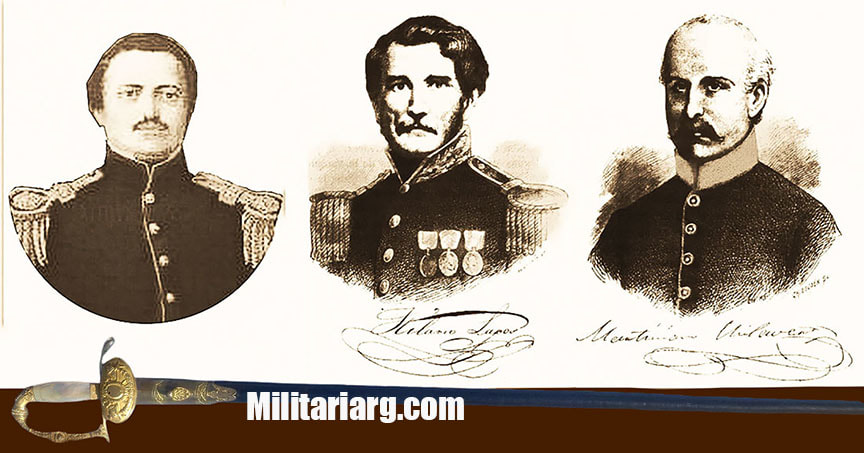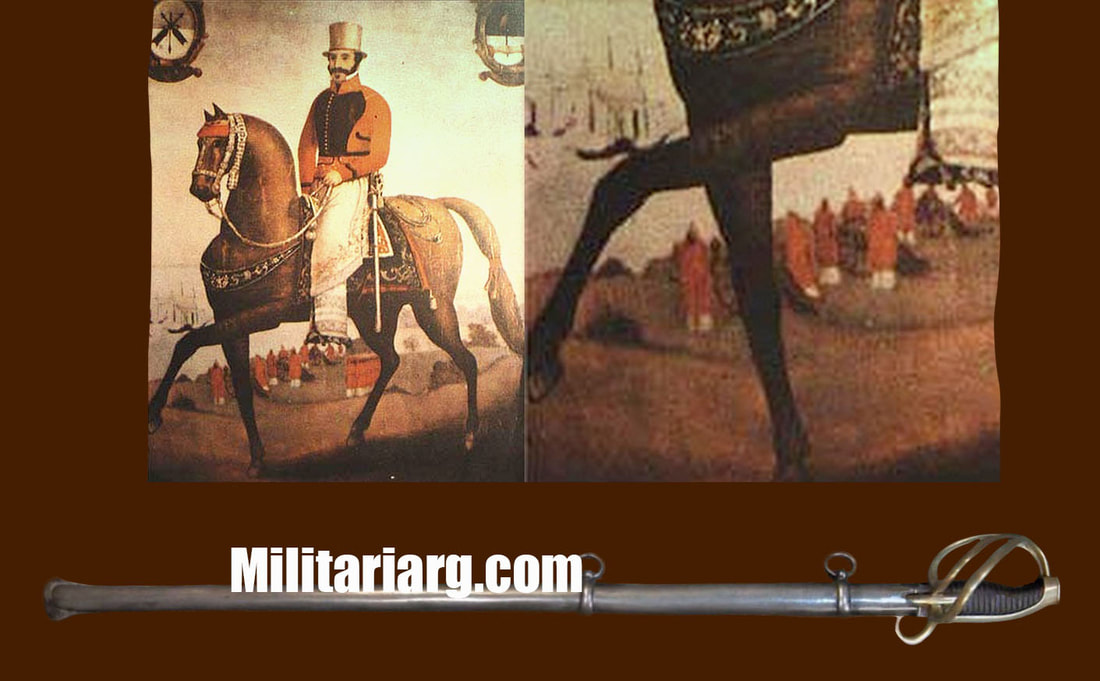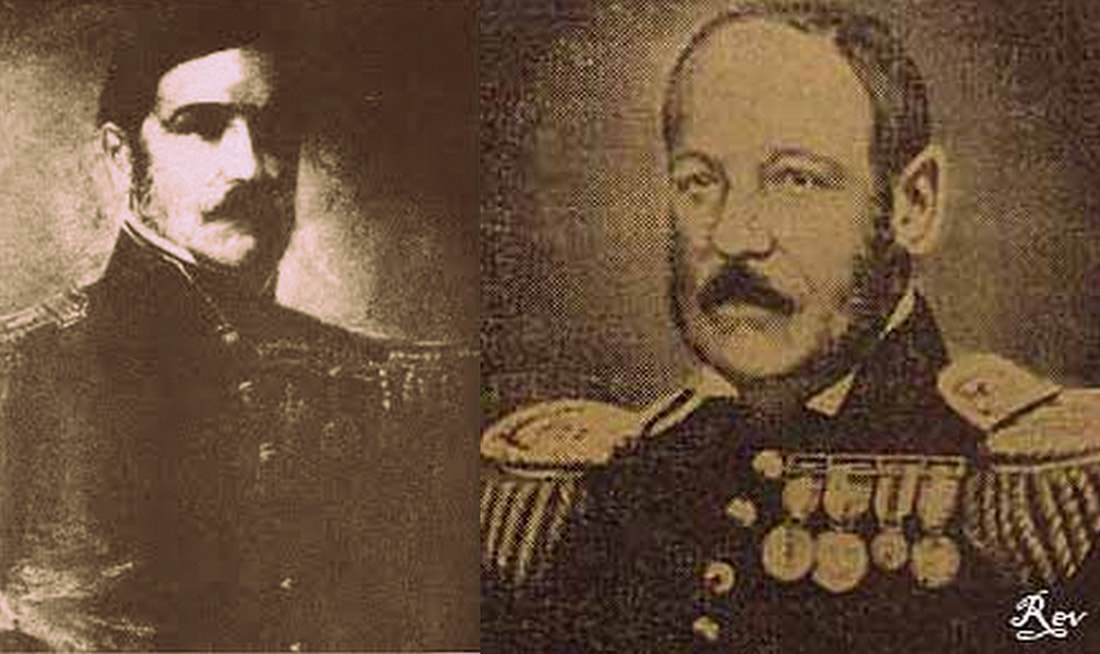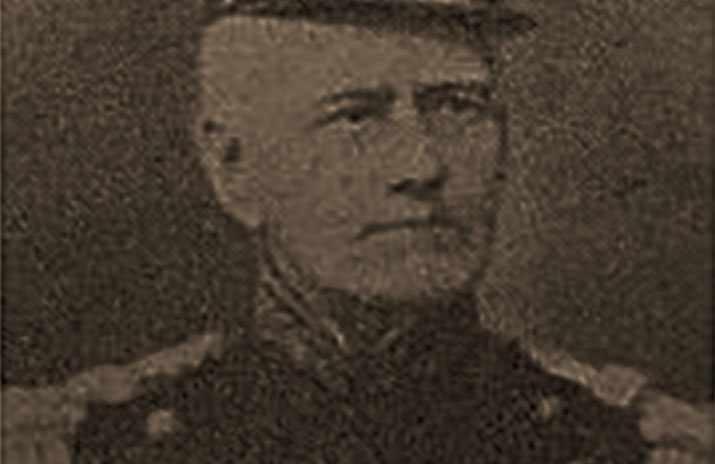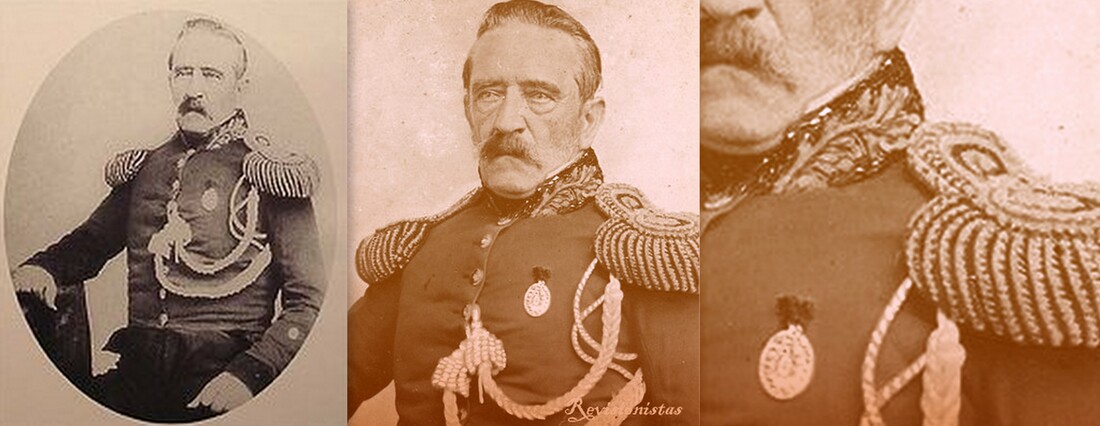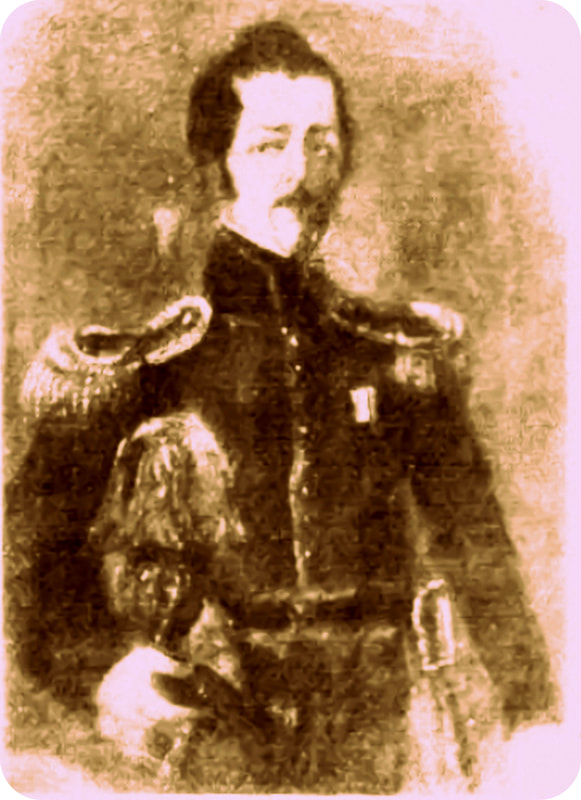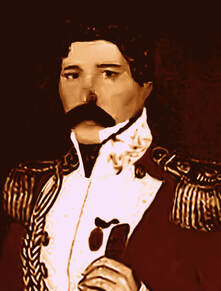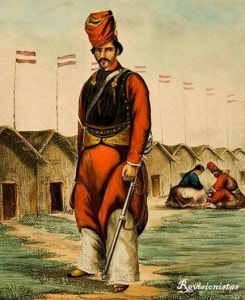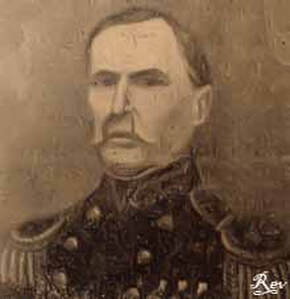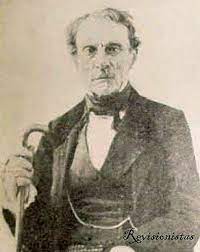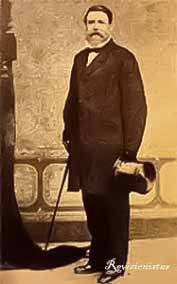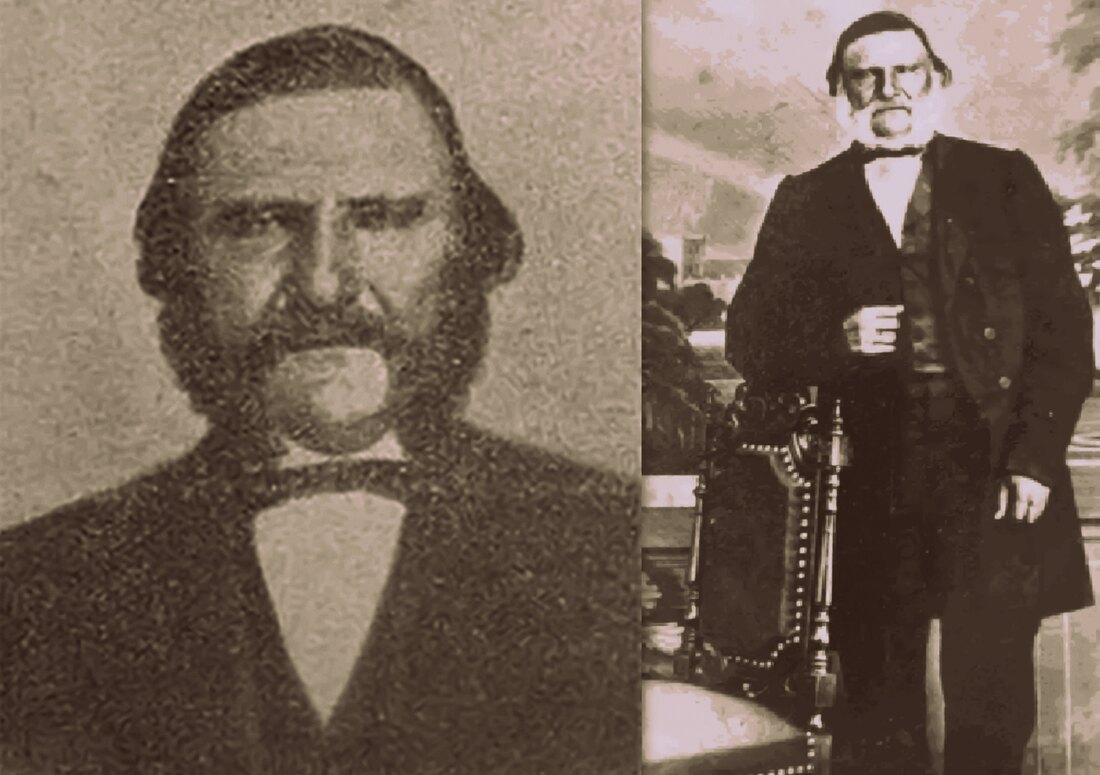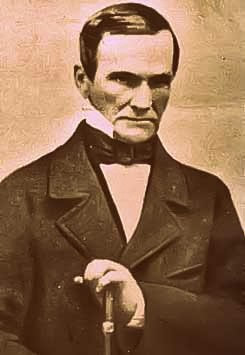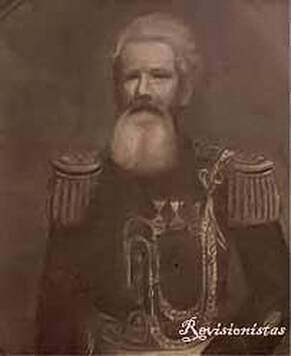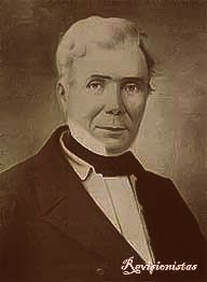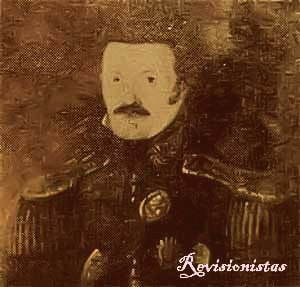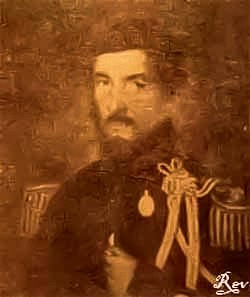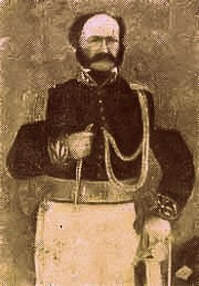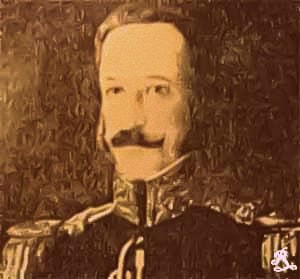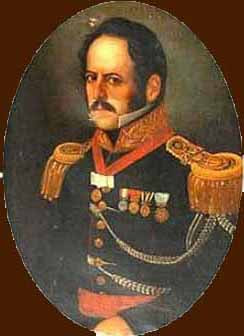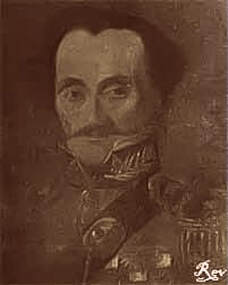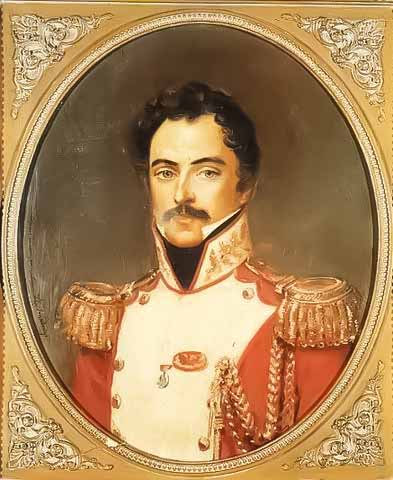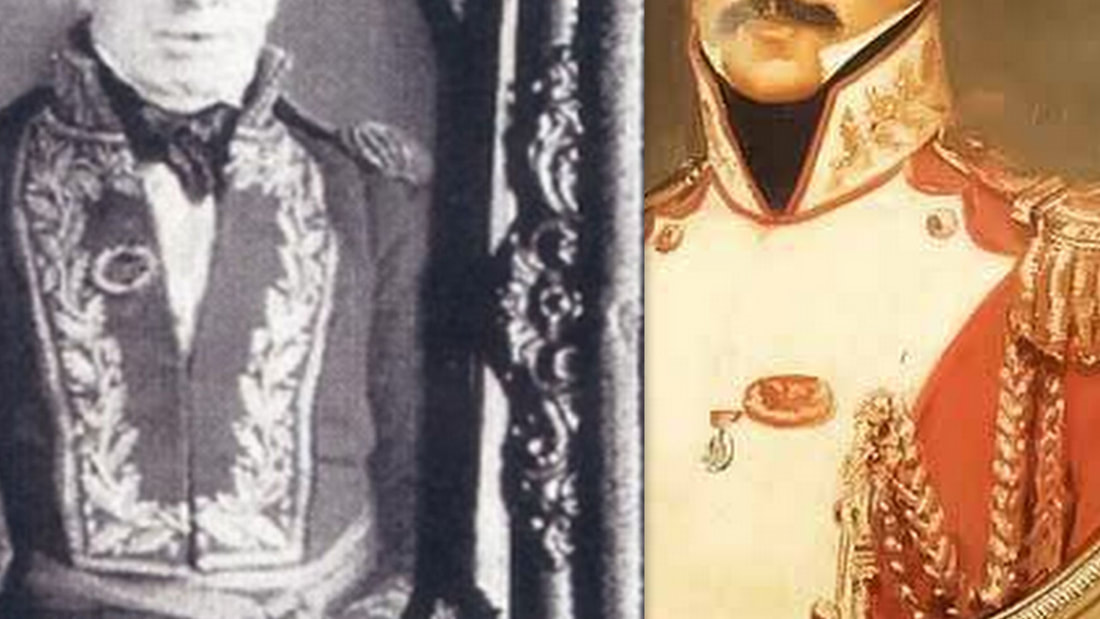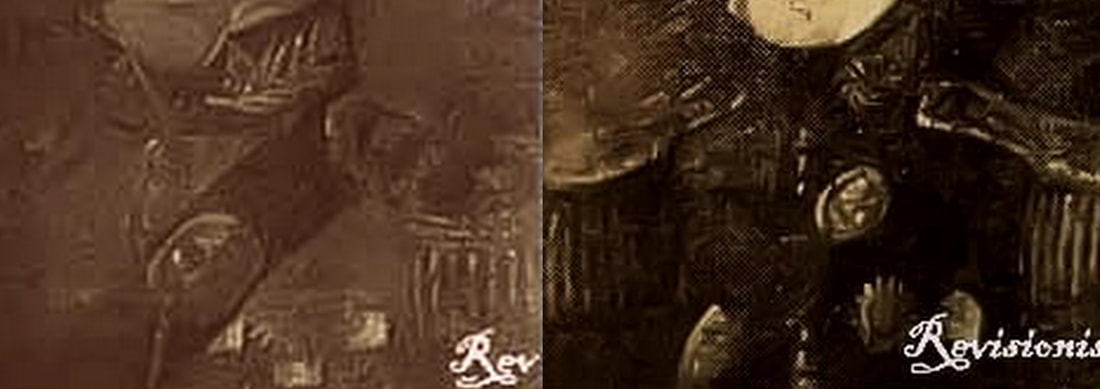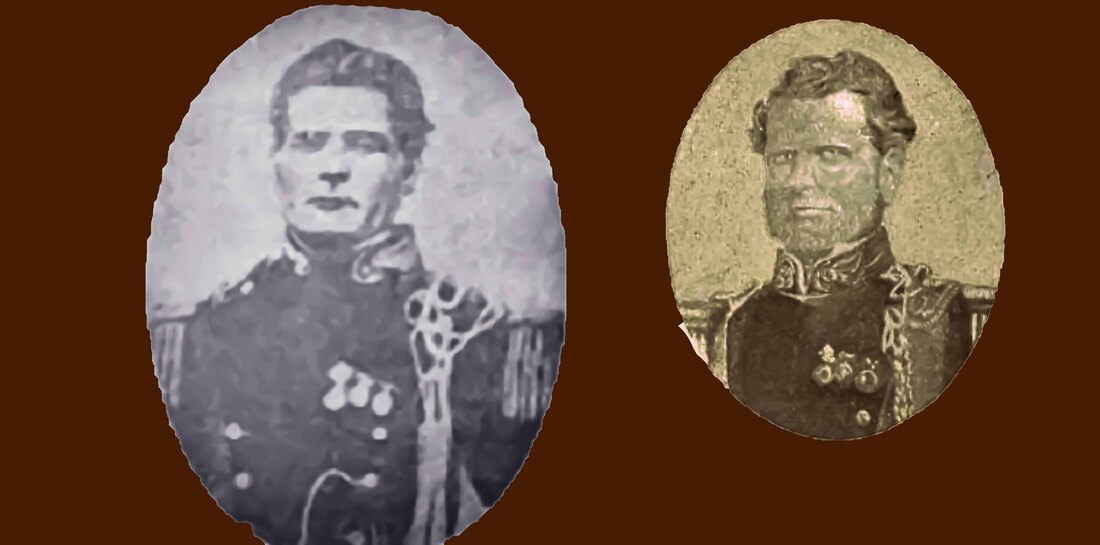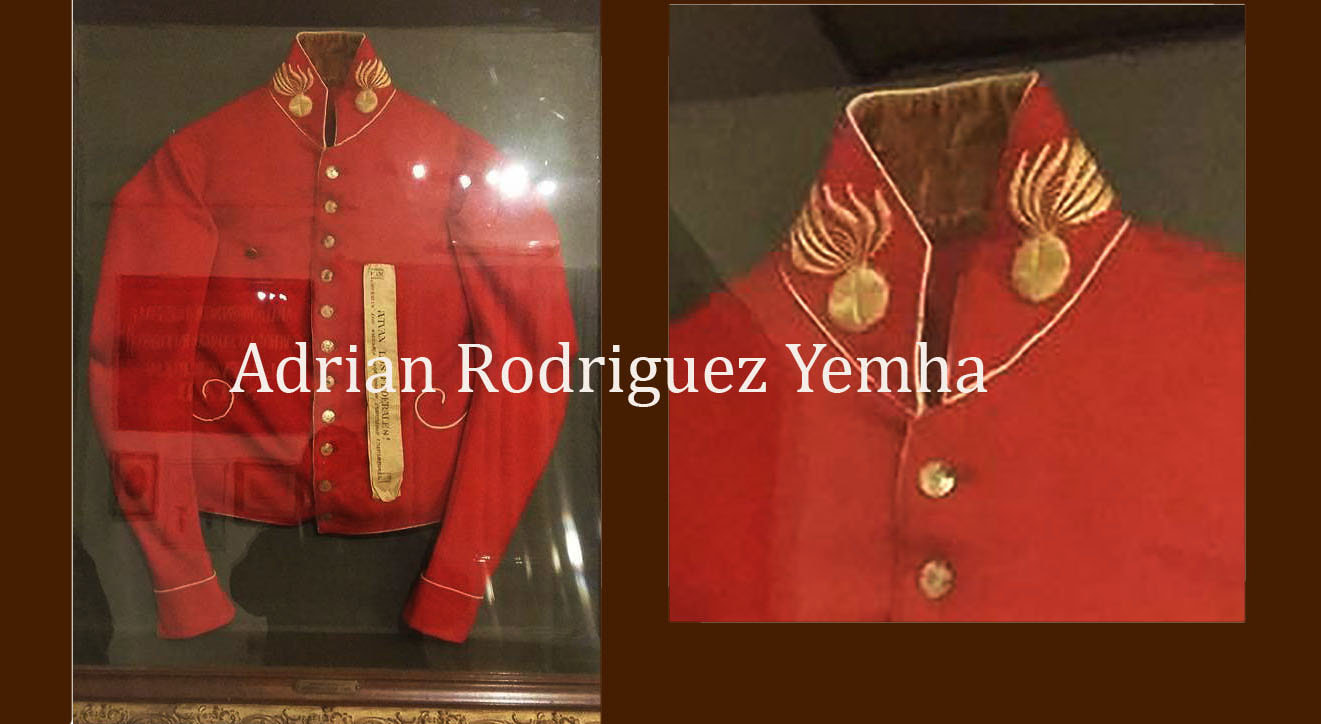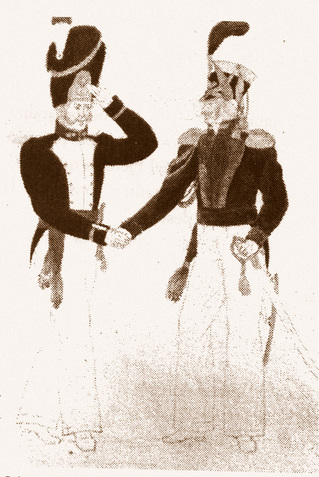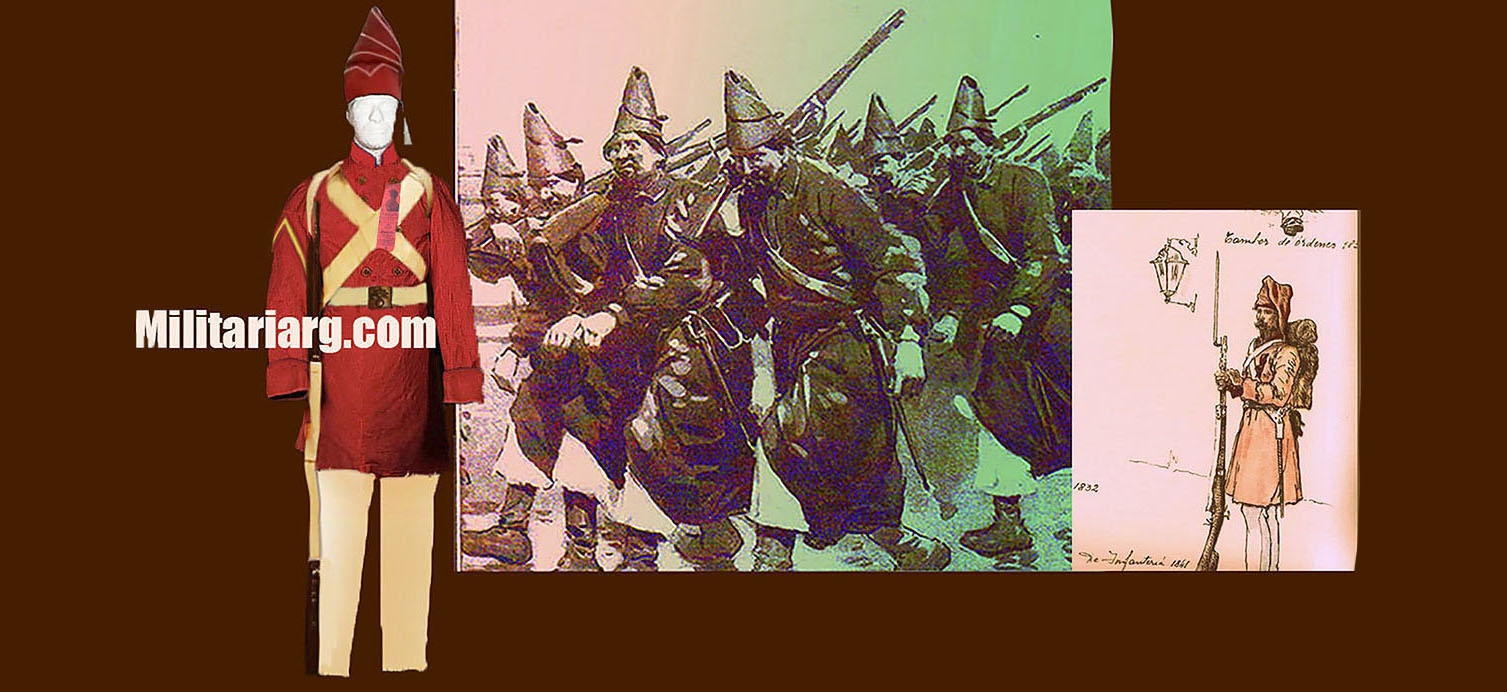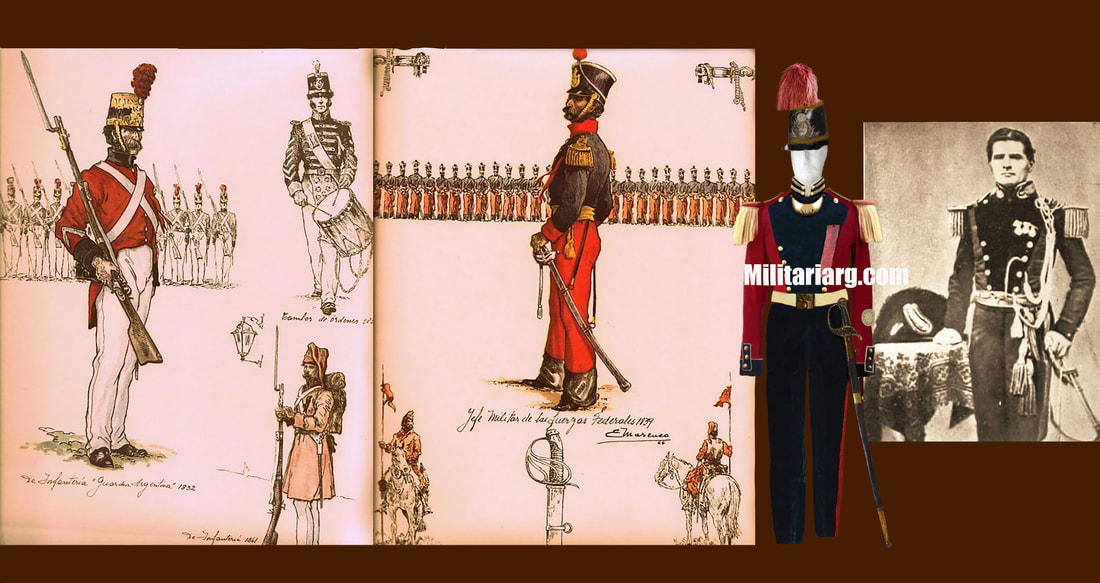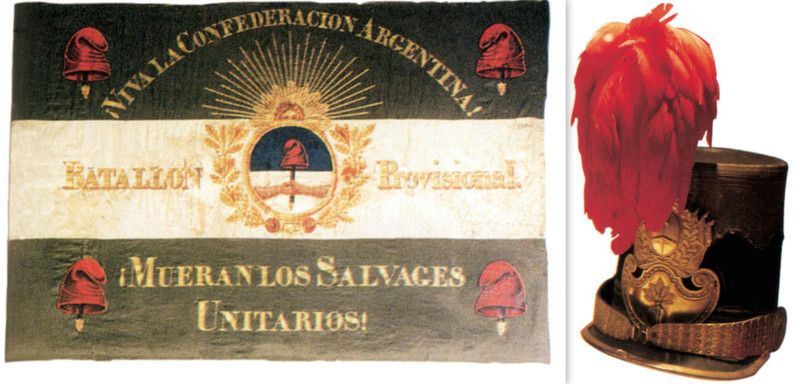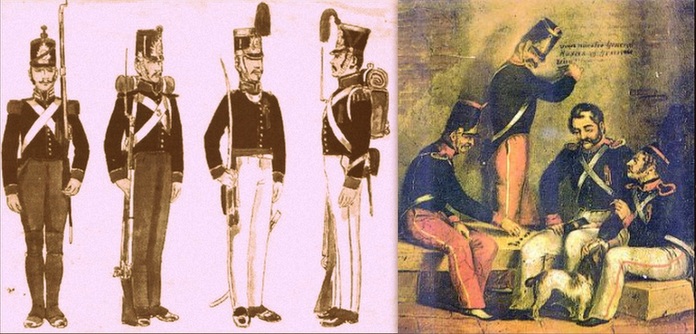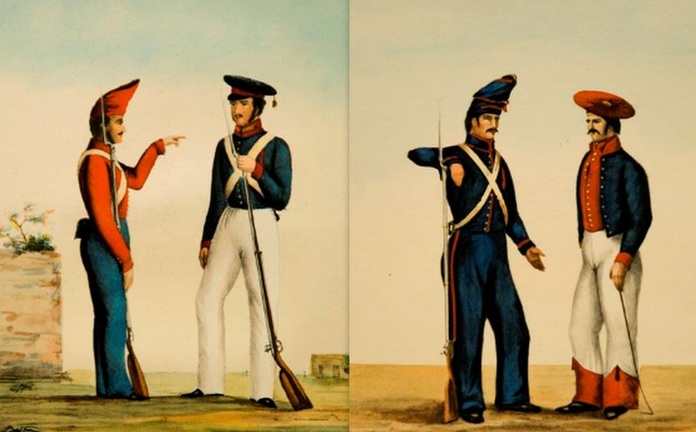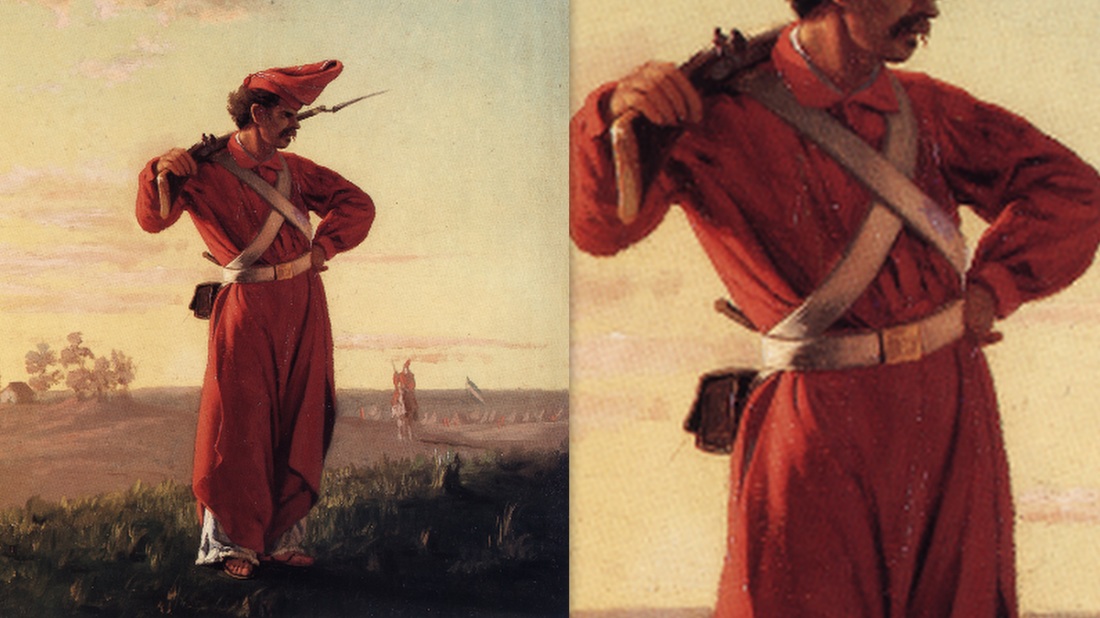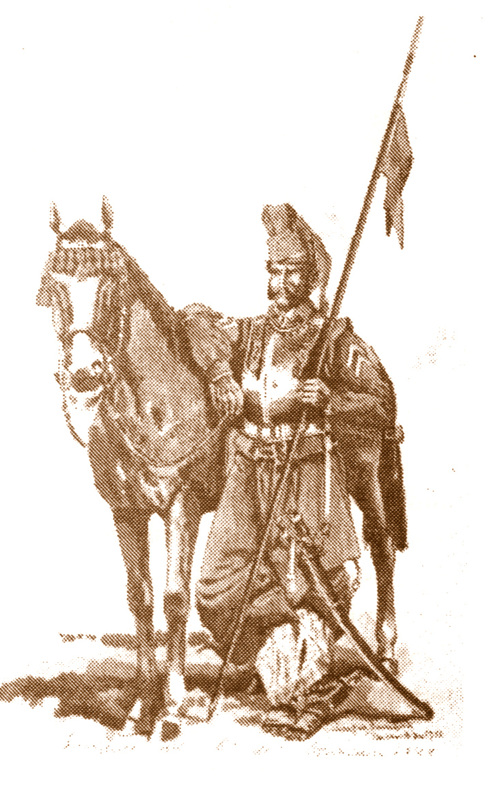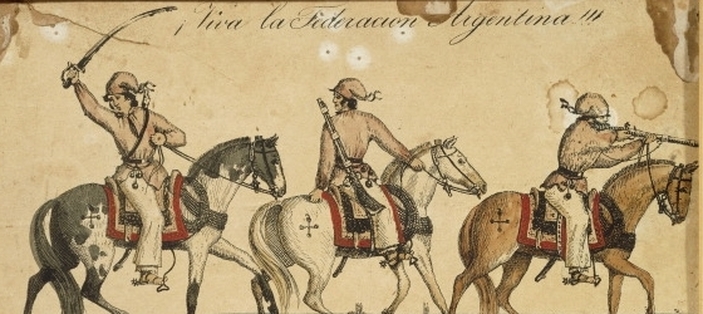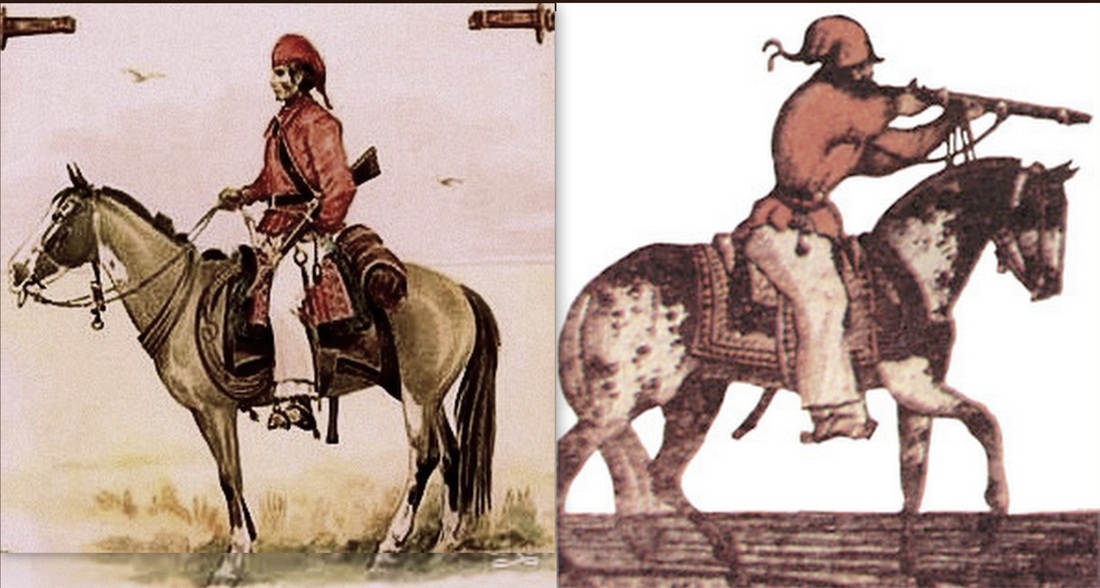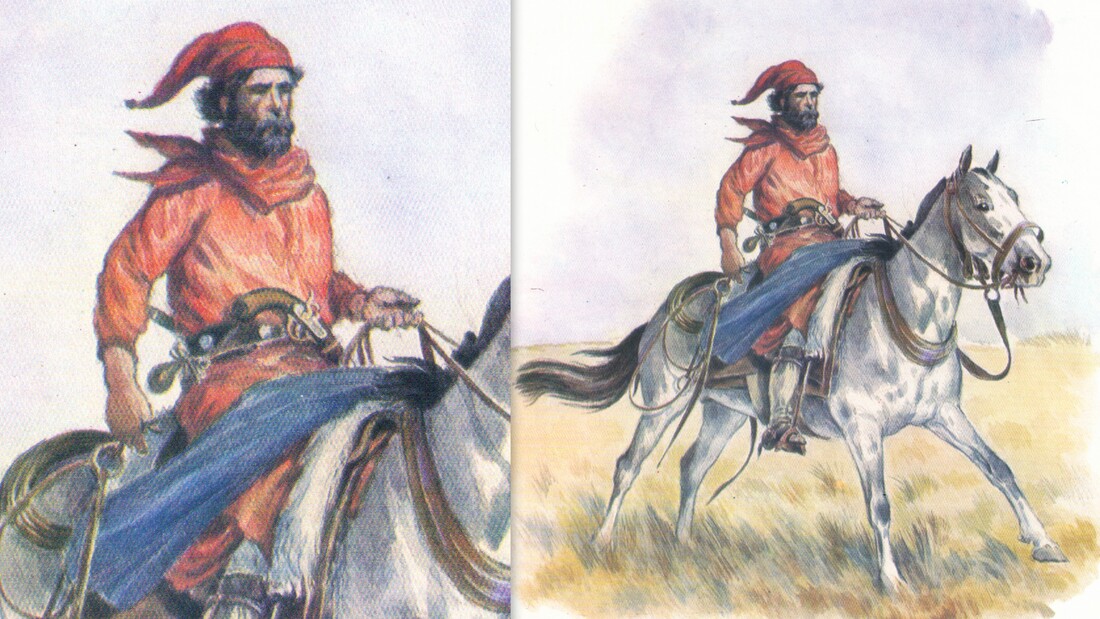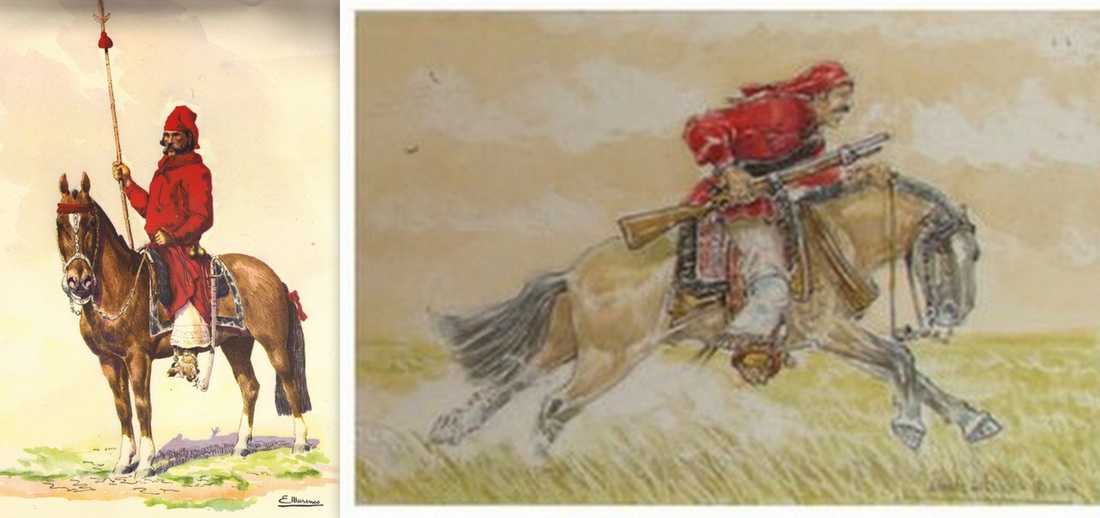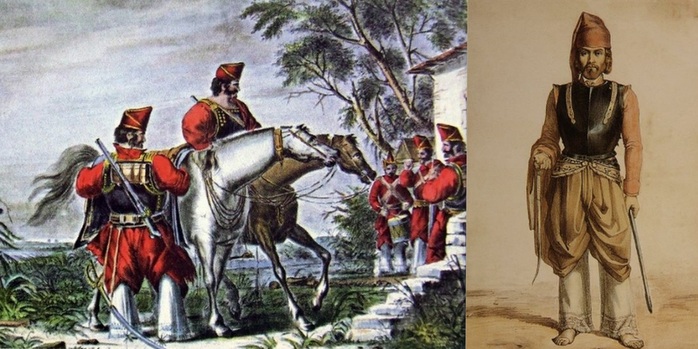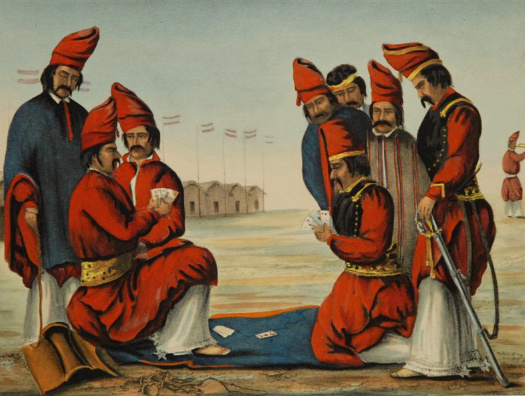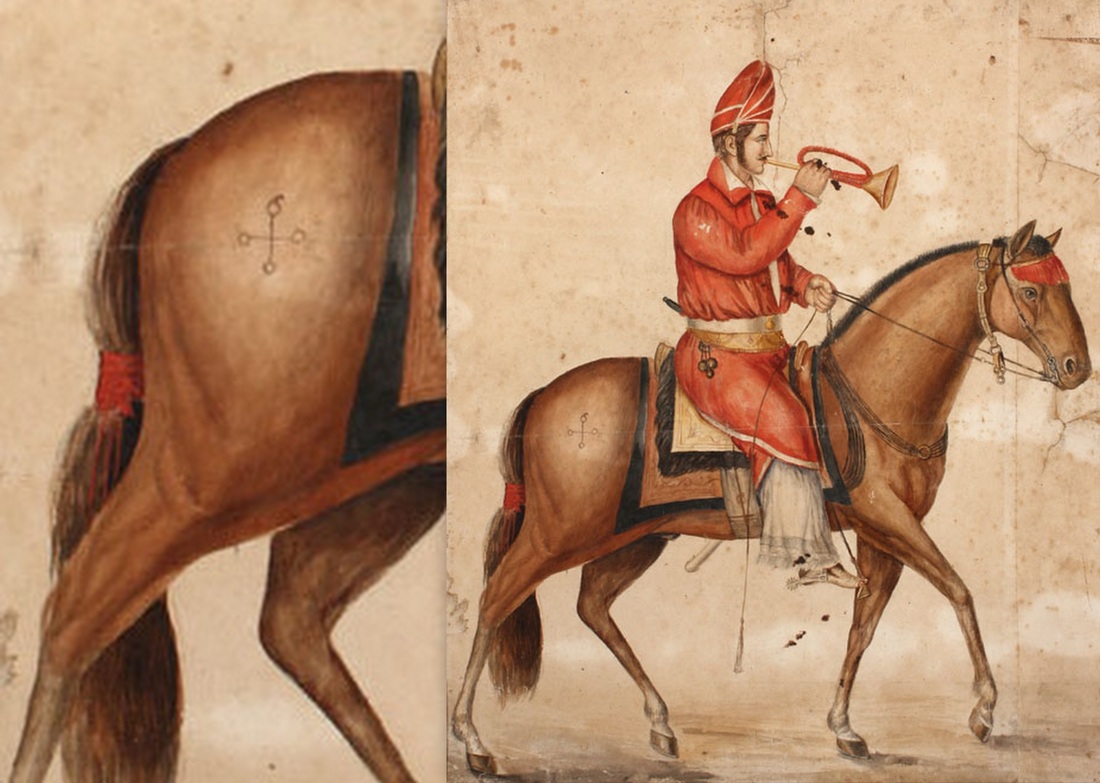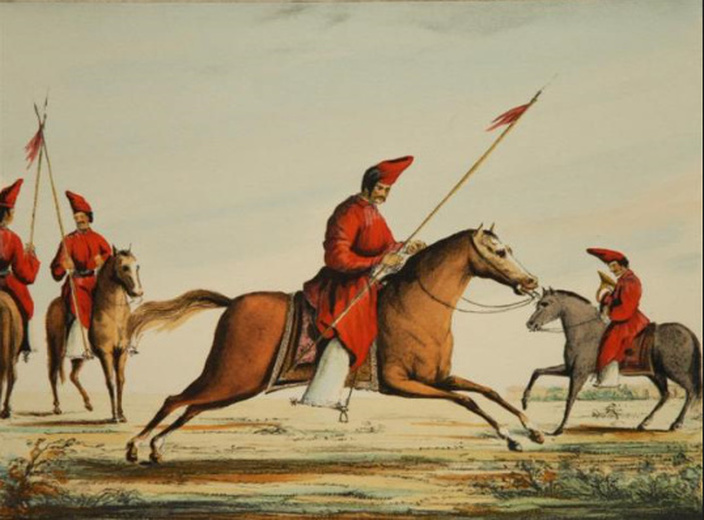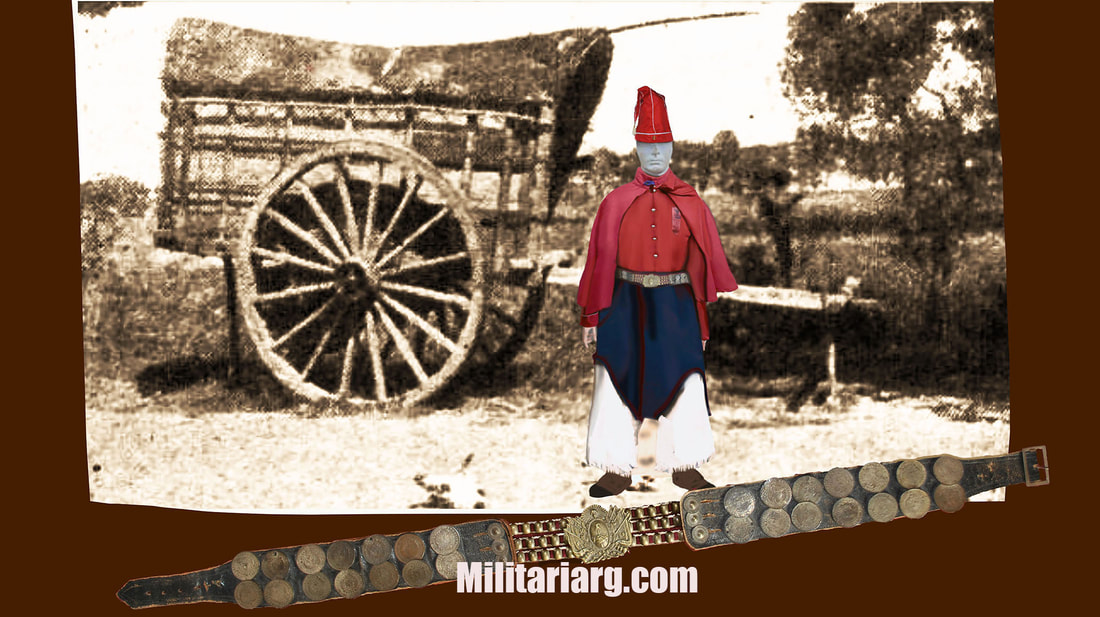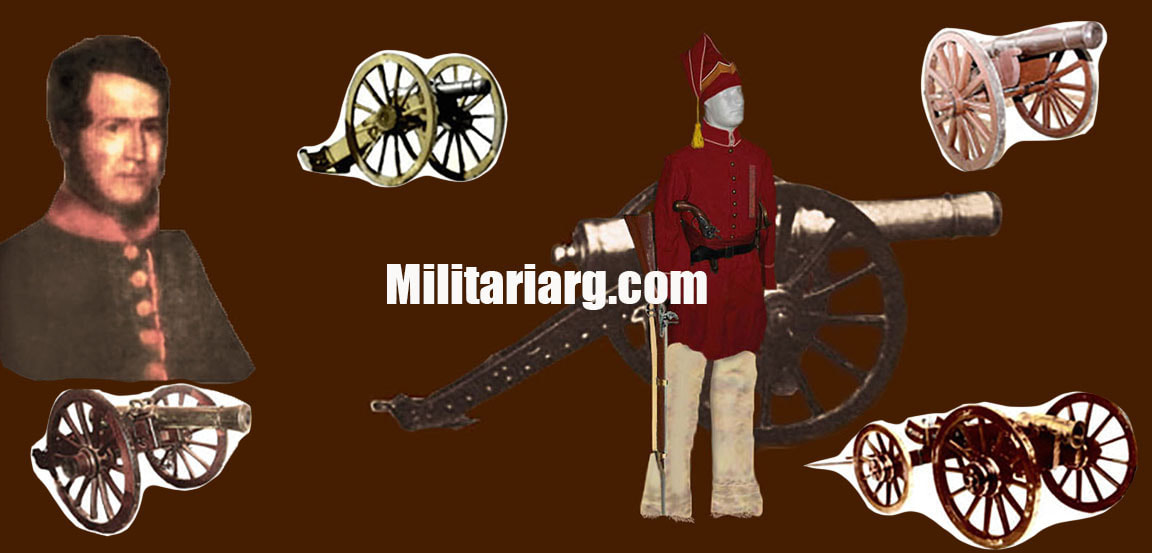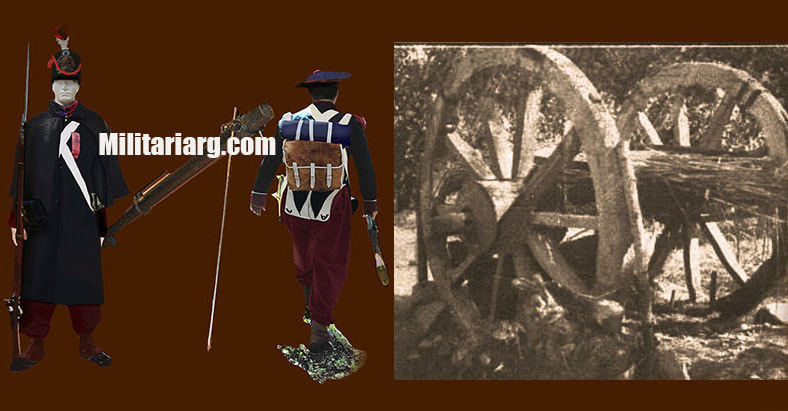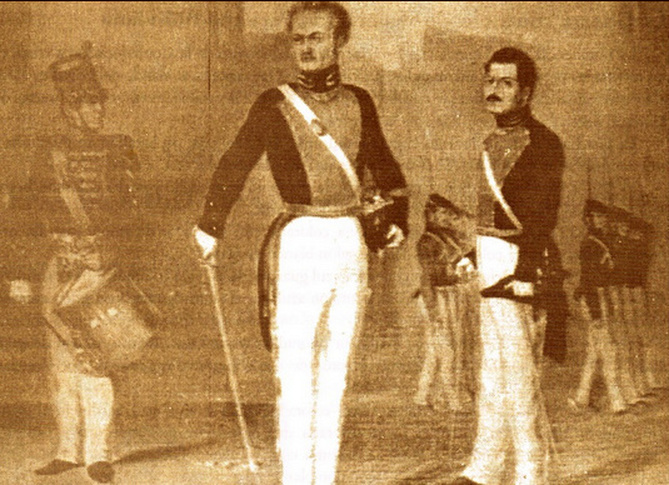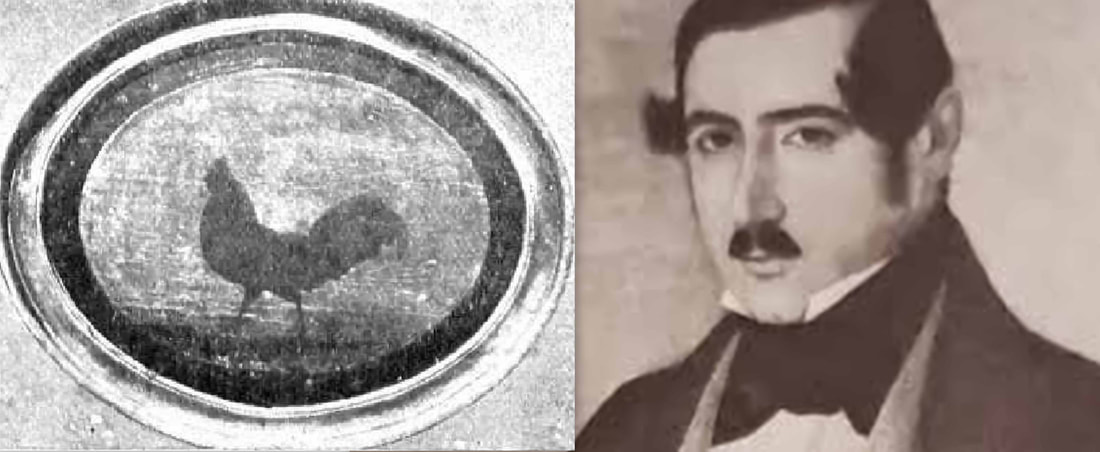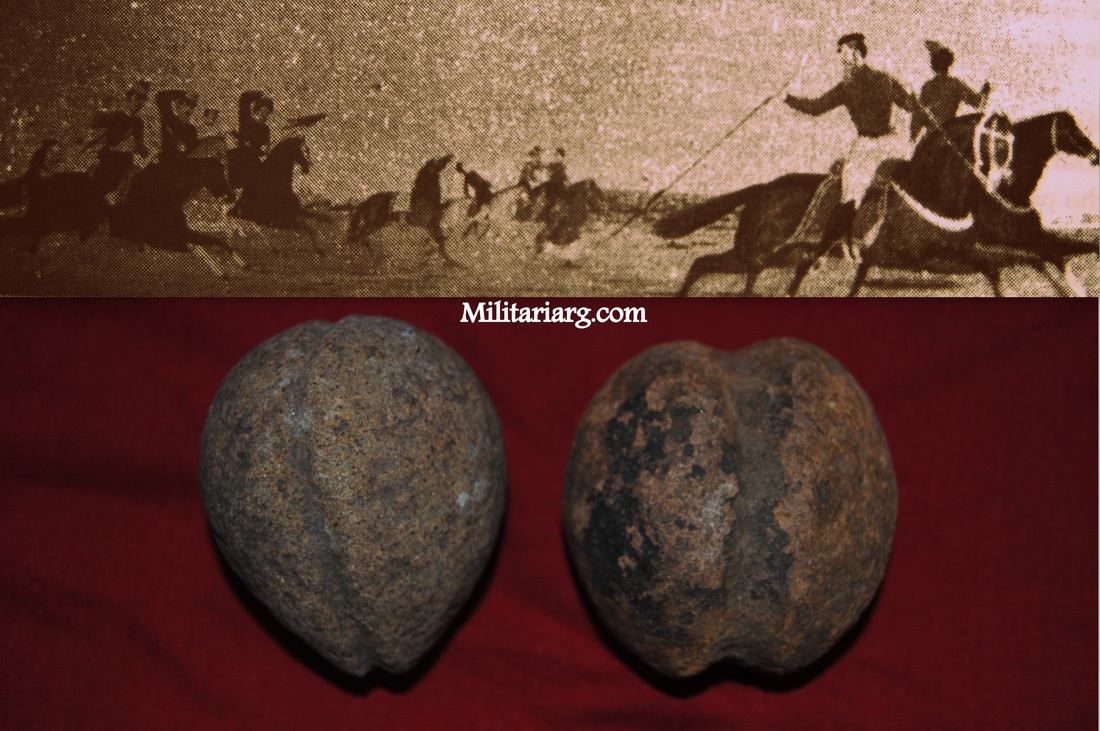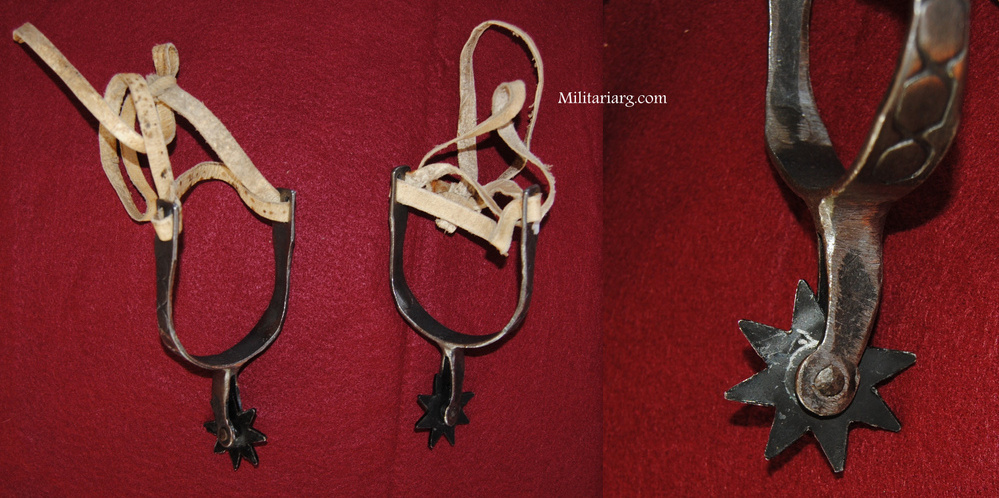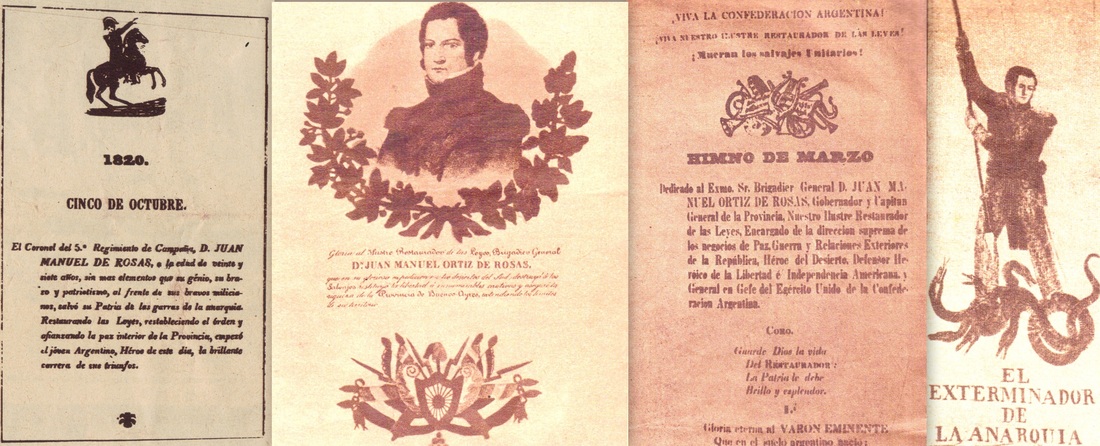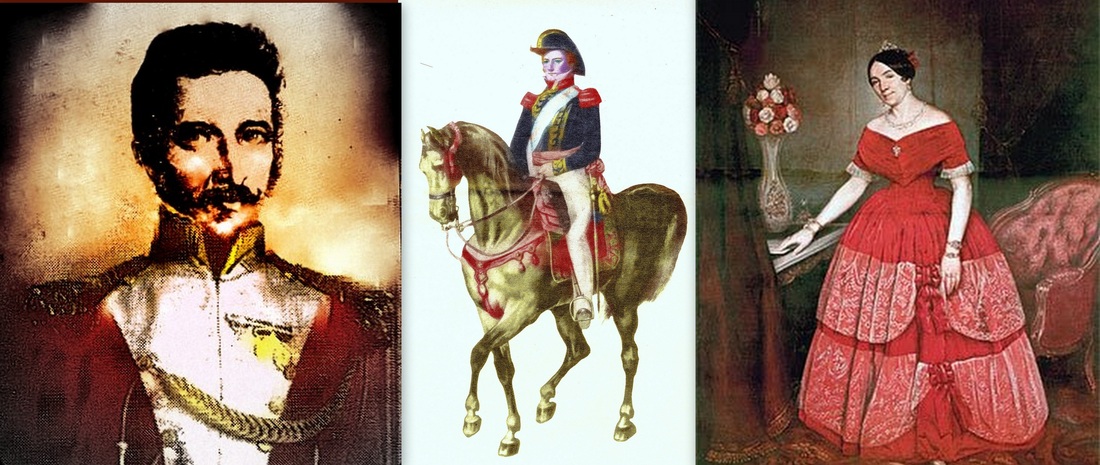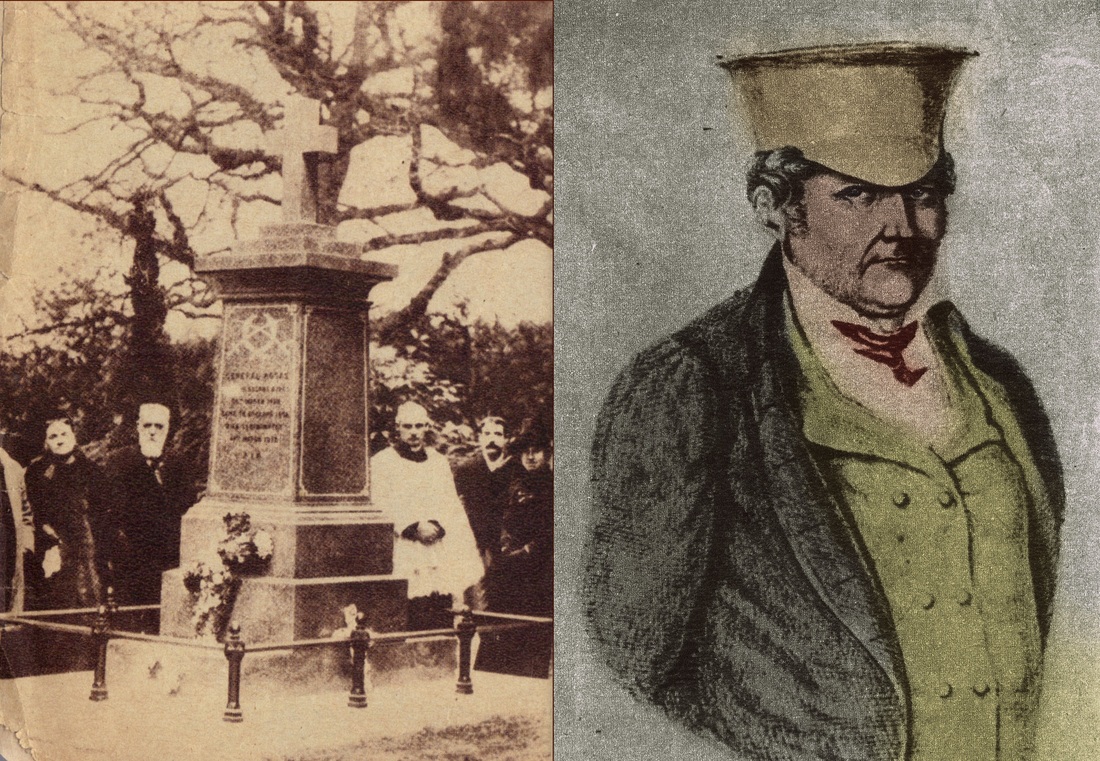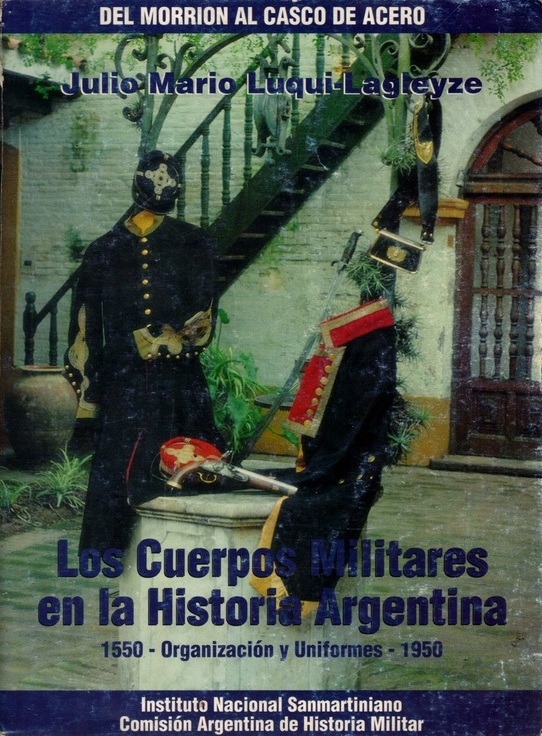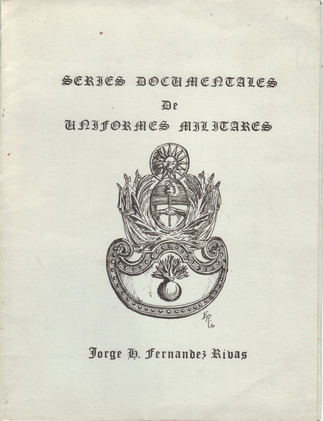Section of the blog dedicated to the study and research of uniforms and militaria in general during a time that is as fascinating as it is unknown. The time of the Argentine Confederation, as seen in the image, also regulated the use of the haircut and beard. At the beginning of the civil wars in Argentina, Federal and Unitarian forces uniformed exactly the same. Both came from the armies of the former United Provinces of the Rio de la Plata and therefore were dressed according to the regulations of the time, a rare mixture of Spanish style and surplus of the British aid to the ex-Spanish colonies. Like this repro cavalry jacket of the Scottish-type. During this exciting time, the European military style was used in combination with local clothes, now considered traditionalist elements. To differentiate themselves from each other, they used a partisan tape like the one on the mannequin. During this time, the Argentine Confederacy suffered a prolonged maritime blockade by the fleets of England and France. For this reason the charge of the Argentine Confederation, Juan Manuel de Rosas had to re-organize the army, and resort to the militarization of civilian garments. Probably the European style uniforms used at this time had been local copies of these. Throughout the 20 years of this stage of the Argentine Confederation, the French style from the time of Louis Philippe (which carried through to the time of Napoleon III) was penetrating from the Montevideo headquarters of the exiled Unitarian forces equipped since the Franco-Argentine War (1838 - 1840). From 1852, after the defeat of the Argentine Confederation, the French style of the Second Empire was imposed definitively until the early 1900s.
Reproduction: Model 1829 Argentine Governor or Captain of Militas Jacket.
Reproduction of Epaulettes Argentine Model 1810 - 1852 for High Commands. General San Martín by Gil de Castro 1818. General Facundo Quiroga by Alphonse Fermepin 1836. Epaulettes of the General Juan Manuel de Rosas Museo Historico Saavedra). Coronel Ramos Uniform (Museo Historico Nacional Buenos Aires).
Reproduction: Type 1805 Red jacket Aide-de-Camp .(Provincias Unidas del Rio de la Plata).
Reproduction: Type 1812 Aide-de-Camp Burgundy (Grana) Color.
Escort Governor. Escolta del Gobernador and Edecans (Aide-de-camp):
On the left and center: Cuirass model 1816 (1st French Empire) cuirassier replica. The short cavalry jacket is a reproduction of an original, based on photographs from a book that showed it in a museum. The jacket is of the Scottish type of the Napoleonic Wars, used in the cavalry regiments of East Lothian, Berwickshire around 1810. Probably the original in the museum in Argentina is of British origin or perhaps made on that same type of garment.
On the right: Colonel Edecan (Aide-de-Camp) reenactment.
On the right: Colonel Edecan (Aide-de-Camp) reenactment.
1826-39. Cuirassier Officer. "Escoltas de la Libertad".
1830. Line Cavalry by Fontenau. "Los Cuerpos Militares en la Historia Argentina".
Ranks:
Brigadier General
Coronel Mayor
Coronel
Teniente Coronel
Sargento Mayor
Capitan
Ayudante 1ro
Teniente 1ro
Teniente 2do
Subteniente
Alferez
Abanderado
Porta-estandarte
Sargento 1ro
Sargento 2do
Cabo 1ro
Cabo 2do
Soldado
Regimental Flags:
Forage cap (Punzo Color), cavalry campaign model replica.
Federal military/political badge:
An original ribbon, political distinctive Federal badge, found in the Netherlands in an old bible in the German language. Probably it would have belonged to a priest who had been added to the Diocese of Buenos Aires at that time.
The origin of this distinction was initially to differentiate the forces of one side and another side, since at that time all were uniformed the same. During the development of the Civil War, and the appearance of France and England in support of the Unitarians, they began to introduce the French military fashion, which became universal in the armies of the world. However, the Federal Army of Argentina according to the old lithographs of the time, evidenced a British style inherited from the support of London during the independence war of the Spanish Empire. Probably that style of clothing was a copy of the English model, as well as the abundance of red and crimson. There were many styles of the ribbon in white and red.
Drawing: 1835. Guardia Argentina Battalion by Guillermo Roux.
The origin of this distinction was initially to differentiate the forces of one side and another side, since at that time all were uniformed the same. During the development of the Civil War, and the appearance of France and England in support of the Unitarians, they began to introduce the French military fashion, which became universal in the armies of the world. However, the Federal Army of Argentina according to the old lithographs of the time, evidenced a British style inherited from the support of London during the independence war of the Spanish Empire. Probably that style of clothing was a copy of the English model, as well as the abundance of red and crimson. There were many styles of the ribbon in white and red.
Drawing: 1835. Guardia Argentina Battalion by Guillermo Roux.
1850. Artillery Officer by Gullermo Roux. A very interesting pair of Double Barrel Flintlock pistols.
2th Bn. "Patricios" and Defensores de la Independencia" 1839-1852 in campaign uniform.
Line Infantry, 3th; 5th; 6th Cavalry Regiment and Trumpeter.
1843 - 1851. Basic Infantry Equipment.
Basic Cavalry Equipment
Chavari riding equestrian pants and black cuirass.
Regiments, Order of Battle and High Command. Colonels; Lieutnant Colonels; Sergeant major (Major), Captains and Lieutnants:
General M. Oribe; General L.M. Mansilla and General A. Pacheco. Note in the photo Mansilla is dressed in his Colonel uniform during the Argentino-Brasilera War of 1825-28. Also note the honor cords of the superior officers. Colonel Chilavert during the Battle of Caseros (where he had to again face the Brazilians) had one from the veterans of Ituzaingo on his blue artillery uniform. Manzilla also had one from Ituzaingo and one from another campaign.
Generals Quiroga and Aldao. In the painting Quiroga wears a French 1st Empire Light Cavalry ceremonial belt and buckle with the lion head. This same type of buckle appears in several portraits of commanders of the War of Independence, not only in cavalry but also in artillery.
Brigadiers (List of 1840)
|
Jose de San Martin
Felipe Ibarra Miguel E. Soler Guillermo Brown |
Pascual Echagüe
Juan Manuel de Rosas Carlos M. de Alvear Jose Felix Aldao |
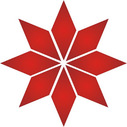
This symbol represents the "Estrella Federal", Each point marks an orientation indicator (North, South, Northeast, etc.) It was the Federal symbol.
This image is a modern representation.
This image is a modern representation.
Oil of Felix Revol preserved in the Historical Museum of Santa Fe with the image of General Pascual Echagüe, governor of the province to the time of the battle of Quebracho in June 1846. Photo: ellitoral.com
Generals (List of 1840)
|
Agustin de Pinedo
Angel Pacheco Tomas Guido Lucio Mansilla Juan Pablo Lopez Manuel Lopez Jose Gregorio Calderon Nasario Benavidez Prudencio Rozas |
Mariano B. Rolon
Felipe Heredia Pablo Aleman Celestino Vidal Jose Ruiz Huidobro Gervasio Espinosa Manuel Corbalan Justo Jose de Urquiza Gregorio Paez |
General Pablo Aleman 1791 - 1845.
Colonels (List of 1840)
Cavalry Colonel Hilario Lagos (Father) 1806 - 1860.
Infantry Colonel Pedro Jose Diaz 1800 - 1857.
\Interesting detail on Colonel Diaz's (Infantry) collar. It seems have a Voltigeur light infantry badge (Bugle horn and flaming grenade on the left, and a huge grenade on the right side) on his 1812 pattern jacket. The Voltigeurs were skirmish skirmisher units created in 1804 by Emperator Napoleon I.
Above left: Colonel Juan Isidro Quesada. On the right the photo of his Argentine Confederation Colonel epaulettes, pocket multi barrel flintlock pistol, medal, and cordon of honor. Photo from the book "Memorias del Coronel Juan Isidro Quesada" 1902.
Left: Original 1821 pattern Order of Merit (Sol of Peru), belonging to Colonel Quesada (Independence War Veteran). Right Colonel Branden Order of Merit.
Above left the uniform of an aide-de-camp (Colonel Pedro Ramos) of the Argentine Confederation. On the right, Colonel Pedro Ramos. Photo Revisionistas.
Colonels Jeronimo Costa (Infantry); Hilario Lagos (Cavalry); Martiniano Chilavert (Artillery).
|
Agustin Rabelo
Pedro Ramos Ramon Rodriguez Juan Correa Morales Bonifacio Ramos Juan Antonio Garreton Lorenzo Rojo Juan Jose Hernandez Segundo Roca Juan P. Luna Francisco Crespo Hilario Lagos Francisco Erezcano Evaristo Uriburu Joaquin Maria Ramiro Nicolas Martinez Fontez Casto Caceres Antonio Toll Pantaleon Argañaraz Andres Segui Jose Montes de Oca Nicolas Granada |
Bernardo Gonzalez
Narciso del Valle Antonio Ramirez Vicente Gonzalez Ventura Miñana Juan Aguilera Martiniano Rodriguez Pedro Burgos Jose Ildefonso Alvarez Arenales Francisco Quevedo Mariano Maza Manuel de la Barcena Jose Maria Pinedo Isidoro Quesada Eugenio Hernandez Juan Valerio Sanchez Martin Hidalgo Juan Garay Jorge Velazco Felipe Santiago Videla Santiago Villamayor Facundo Borda |
Jose Rufino de Zado
Cayetano Laprida Fabian Rosas Roque Cepeda Joaquin Hidalgo Julian Vega Manuel del Carmen Garcia Jose Maria Flores Matias Garcia Ramon Quevedo Andres Parra Jose Santos Ramirez Ciriaco Cuitiño Bernardo Echeverria Julian Salomon Bruno Ponce de Leon Ramon Mendez Juan Pablo Sosa Manuel Delgado Bernardino Vera Estanislao Recabarren Hilario Ortiz |
Colonel Martin Santa Coloma.
Lieutenant colonels (List of 1840)
|
Geronimo Costa
Ramon Bustos Jose Corbalan Pedro Lorca Martin Santa Coloma Juan B. Navarrete Juan Zeballos Antonio Giles Jose Arias Acosta Eugenio Barrios Jose Ignacio Burgos Celestino Vazquez Benjamin Mendez Manuel Maestre Francisco Moreno Marcos Paz Felix Meneses Salvador Maria Gonzalez |
Justo Oliva
Mariano Espinosa Manuel Vorto Manuel Brizuela Angel Rivas Rafael Masias Lucas Llanos Jose Pons Antonio Espinosa Jose Tomas Beruti Agustin Vidal Rafael M. Fuentes Juan Osorio Santiago Baldeon Pedro Jose Dominguez Carlos Bownes Angel Rolon Miguel del Rio Juan Mendez Felix Ponce |
Luis Maria Salguero
Juan Ramon Urien Benito Millan Fernando Visillac Julian Ciriaco Sosa Jose Zereso Baldomero Lamela Jose Ramon Islas Manuel Capdevila Manuel Seiva Francisco Morell Luis Palavecino Mariano Figueredo Juan Francisco Diaz Francisco Moyano Pedro Juan Obredo Patricio Lima |
Source: "Vindicacion y memorias" by Antonino Reyes, Volume 1; Gaceta Mercantil 1840.
Colonel Nicolas Granada.
Colonel Jose Prudencio Brown Arnold.
Colonel Ramon Rodriguez. Commander of the Patricios Infantry during the Obligado Battle. Photo: Revisionistas
Colonel Cayetano Laprida 1804 - 1868.
The capture shows the detail of an interesting red oval badge on the lapels of the uniforms of Admiral Brown and the Edecan Coronel del Valle.
French type bandolier. Lion head and grenade. Detail of the uniforms of Colonels Jose Montes de Oca and Juan Valerio Sanchez.
Colonel Pedro Jose Diaz 1800 - 1857
This is an authentic short cavalry jacket of the Argentine Confederation (Saavedra Museum). Many thanks to Adrian Rodriguez Yemha for sharing with us.
Infantry Units:Cazadores del Rio de la Plata.
Left: Officers of the Guardia Argentina and The Rio de La Plata by Joseph Fontenau. "Los Cuerpos Militares en la Historia Argentina". |
The mannequin is dressed like an infantry soldier in a campaign uniform (Circa 1840), with equipment and webbing.
On the right, an original Argentine-Confederation Shako, possibly in some Montevideo Museum or Collection; Note the wavy gallon,which probably came from the bicorn pattern for Superior Officers. Photos: Kalipedia.com
1840. 2th "Patricios Battalion". Right: Line Infantry. "Los Cuerpos Militares en la Historia Argentina" by Julio Mario Luqui-Lagleyze.
Cavalry Units:Escort Governor. Escolta del Gobernador.
|
6th Regiment Cuirassier by Beufort. "Los Cuerpos Militares en la Historia Argentina".
|
Coraceros, Cuirassiers Lithography by Juan Carlos Morel.
Artillery Units:
Batallon de Artilleria de Buenos Aires.
Compania de Artilleria de Buenos Aires.
Spanish 4"; 6"; 8" Fiel Gun. French/Spanish 12" Field Gun (Gribeouval System). Right: British 5.5" Howitzer.
Guardia Argentina Battalion Fusiliers (Fusileros), Riflemen (Cazadores). Artillery company congreve rocket launcher and wagon of that time.
Left" Artillery Batallon Officers and Regimental Drum. Right: Line Infantry Soldier. Brigadier Cornelio Saavedra Museum. Los Cuerpos Militares en la Historia Argentina".
Police Corps:
Juan Moreno. He was Chief of the Federal Police of Buenos Aires between 1845 and 1852. He was born in the Banda Oriental. Next to it is an old police plate with the symbol of the Gaullic rooster from his time.
Collectibles:
In the photo, a pair of boleadoras which was an arm used militarily (among other uses) to down enemy horses. In the above photo you see an officer and his assistant in retreat being pursued by the advancing enemy. Note the use of the boleadoras and how the officer tries to neutralize them with the base of the lance so that they don't make it to the horse's legs. The ones I have are made from etched rocks, but some were made more elaborately of metal.
Gaucho Knife (Facon).
Argentine Gaucho Spurs.It is a typical element of Argentine folklore. By the middle of the 19th century, the gauchos nicknamed them "Nazarenas" because of their resemblance to the crown of Christ, and also "Lloronas" (cry babies) for the noise they made.
Gaucho belt and buckle (Cinto y rastra). This gaucho belt is authentic and original Federal party one. It was found in England and is adorned with coins from the 19th century, after 1852. The buckle is made of brass, with the shield of the Argentine Confederation.
Memorabilia:
Documents:
Paints, Daguerreotype, Photos, Lithographs:
Colonel Reyes, (Edecan). J.M Rosas and Manuelita Rosas.
Rosas grave. Old Cemetery Southampton Hampshire, England
